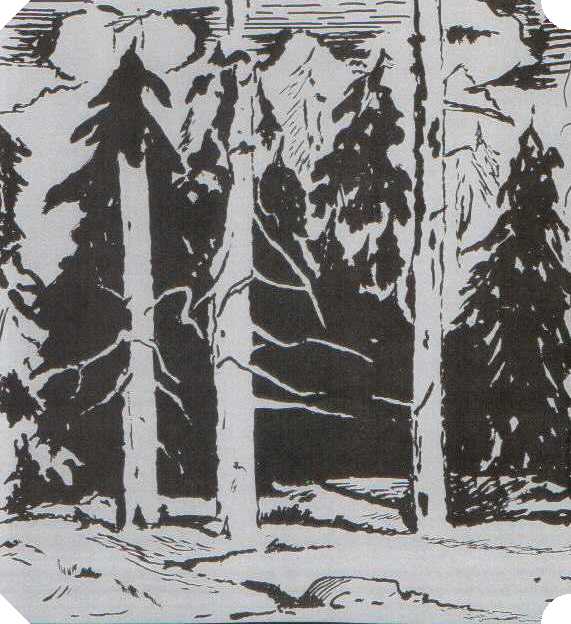

From Wilderness to Wilderness: Celestia by D. Wayne Bender An Historical and Theological Overview Published by The Sullivan Review, Dushore, PA 18614 |
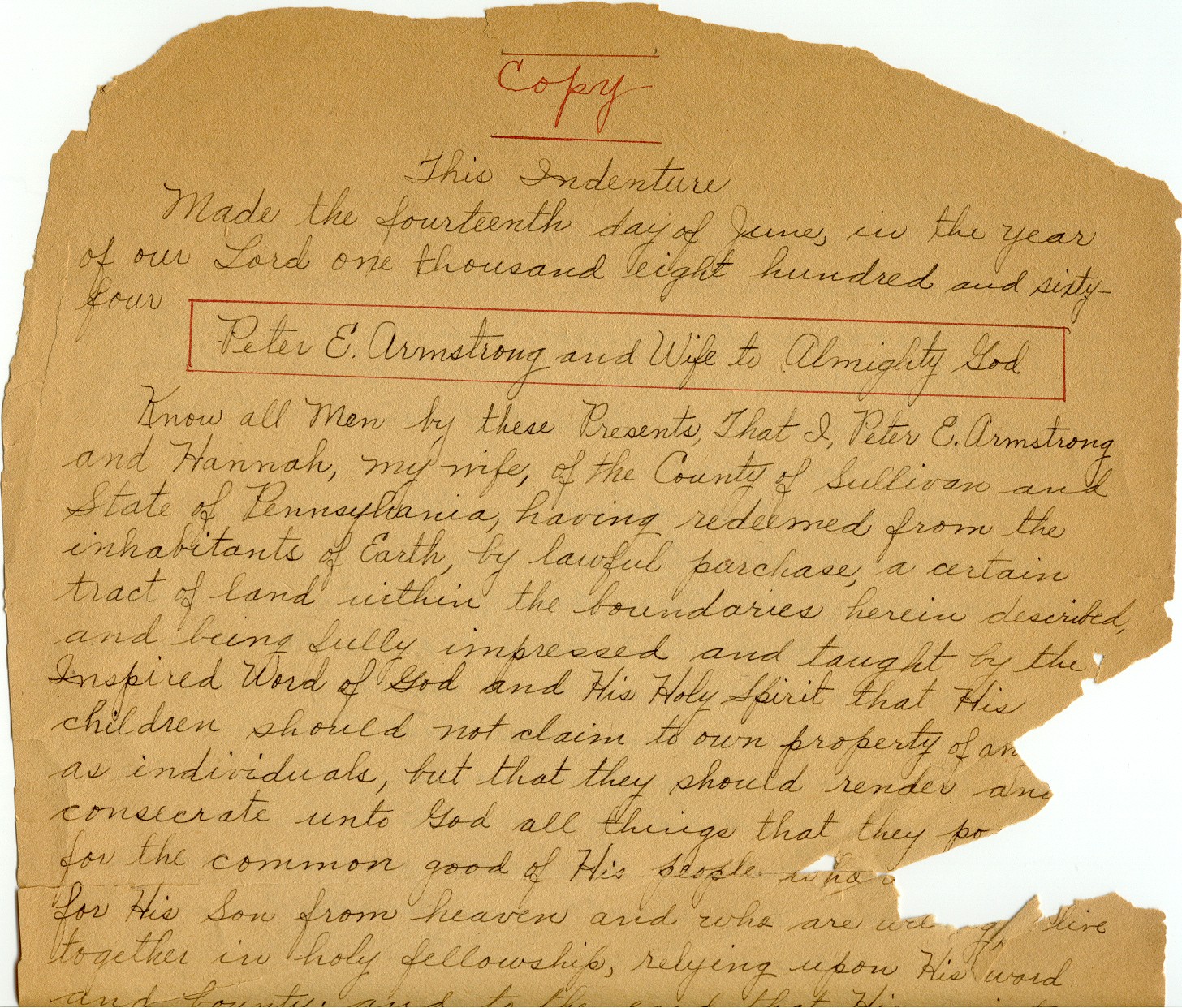
Indenture Willing the Land Under Celestia to God
Top half of first page
June 14, 1864
DEDICATION
To: the Directors of the Sullivan County Historical Museum who are working to keep Sullivan County's history
alive within the hearts of the young and old
and
To: Donald C. Bender
PREFACE
The history of Celestia, Sullivan County, has been the interest of young and old ever since the collapse of the community. Since that time several local historians have written short histories, each focusing on a different aspect of the sect's development. Because primary sources are limited and many secondary sources are factually questionable, the complete history of Celestia has been lost. Before Celestia becomes merely a memory about a "strange deed" to Almighty God, the history has now been preserved. In accepting such a task every effort has been made to rely on the writings of the leader, Peter E. Armstrong. Where this has not been possible the author has suggested the most logical order of events. It has also been helpful to locate the history of Celestia within the social and religious environment of the early nineteenth century. **
I wish to thank Dr. Donald E. Byrne, Jr., of Lebanon Valley College, for his forceful, guiding, and understanding hand. His leadership and support as the "task master" has been the motivating force necessary for this booklet's completion.
Also, it is only through the cooperation of Mrs. Rita A. Wharton, oldest living descendant of Armstrong, that much of the information has been retained. Her excellent memory, her desire to help, and her active interest have been greatly appreciated.
Mr. and Mrs. Edmund Hill have also been very supportive of this project. Special thanks is due to Mr. Hill for the cover design.
Others whom I wish to thank for their support and interest have been: Mr. and Mrs. Robert Armstrong, Mr. and Mrs. James St. Clair, Mr. and Mrs. Harold Sheets, Mr. and Mrs. Leon McCaslin, Mr. W. R. Stepp, Mrs. Jane Sheets, Mrs. Hazel Starr, Diane Rogers, Lynne Miller, Charles Mershon, Nancy Shaner, Robert McGuire, and Mrs. Leona Bender. To all, and many others: THANK YOU!
D. Wayne Bender
** Editor's Note: In November 2007, a group of undergraduate college students at Rockhurst University in Kansas City, MO, produced a course project paper on the history of the Celestia. The paper drew heavily on the Bender history produced here. You can read a copy of the 2007 paper here: Celestia: An Experiment in Nineteenth Century Divine Communism.
It might also interest the reader to
examine Celesta at Its Best, which provides additional descriptive details about the community, in the July 1951 edition of Now and Then.
TABLE OF CONTENTS
I. Introduction.......................................page 1
II. The Vision: Armstrong's Theology...........................................page 6
III. Beginnings of the Vision....................................................page 12
IV. Obstacles to the Vision ......................................................page 20
Celestia VS. The United States Government................................... page 20
Deeding the Land to God........................................................ page 22
Unbelievers Force the Development of Glen Sharon................................page 25
The Obstinate Miss McClain......................................................page 30
V. Armstrong's Vision Renewed:...................................................page 34
The Day Star and The Temple .................................................page 34
VI. Denouement....................................................................page 37
VII. Epilogue......................................................................page 39
VIII. Footnotes.....................................................................page 45
IX. Bibliography..................................................................page 55
INTRODUCTION
The early nineteenth century in the United States was a period of intense religious experimentation and growth. Sparked by the flames of revivalism, old religions renewed themselves, split and combined with others, while new doctrines and beliefs seemed to sprout in every corner of the expanding frontier. Some groups preached perfectionism; others announced new revelations. Optimistic about the future, dreamers founded utopias in the wilderness. Millennialists, on the other hand, saw signs of the end at every turn, and called their followers to await Armageddon.(1)
Within the religious turmoil of the day this millennial belief --- that the world would end when Christ came to earth to claim his Bride --- found acceptance among those believers called Millerites.
(2) William Miller (1782-1849), the founder of Millerism, believed that the Messianic prophecies of the Bible were to be interpreted literally, and could be applied to the present age. Through careful study of the scriptures he calculated that Christ would return to earth and cleanse the earthly sanctuary two thousand three hundred years after the beginning of the prophetic period in 457 B.C., when the command to restore Jerusalem was given.(3) Therefore Miller, a farmer turned preacher, taught that Christ's second advent would occur sometime between March 21, 1843 and March 21, 1844. He stated:I believe the time can be known by all who desire to understand and to be ready for His coming, I am fully convinced that sometime between March 21, 1843, and March 21, 1844, according to the Jewish mode of computation of time, Christ will come, and bring all His saints with him; and that then He will award every man as his work shall be.(4)
In 1833, Miller began preaching his message in local churches throughout New England.
(5) Later, in 1840, Miller was joined by Joshua V. Himes of Boston, who helped spread the urgent message thoughout the United States and Canada.(6) Together, they taught their followers to remain within their denominations while preparing themselves and others for the second advent.(7)The religious ferment of the nation grew as the date of March 21, 1844 drew near. Many people did not even plan for their futures after March 21 because they were certain that their faith was without error.
(8) After this date had come and gone, S. S. Snow declared Miller had erred in his prophetic calculations because he had used a Roman calendar rather than a Jewish calendar. Using the alternate calendar, Snow set the new millennial date for the "tenth day of the seventh month" Jewish time or October 22, 1844.(9)Given a new lease on time, Miller and Himes intensified their efforts to ready people for the coming of Christ. Such was their influence that the summer of 1844 was a time of jubilee. Farmers did not harvest their crops, people sold or destroyed their homes and belongings, families were broken up, and during the last days prior to October 22, many businesses closed.
(10)The prophetic message had gained such strength and appeal that when October 22, 1844 passed into history, the Millerites scattered, embarrassed by their faith, and the day became known as the Great Disappointment.
(11) However, yet another reinterpretation was in the offing. Hiram Edson, an associate of Miller's, proclaimed that the sanctuary cleansed was in heaven, not on earth as Miller had predicted. Together with O. R. L. Crozier he studied the scriptures and found a key in Hebrews 8:1-2: "We have such a high priest, who is set on the right hand of the throne of the Majesty in the heavens; a minister of the sanctuary, and of the true tabernacle, which the Lord pitched, and not man." What this meant, accoring to Edson and Crozier, is that on October 22, 1844, Christ did enter the heavenly sanctuary, and after cleansing it he would return to earth.(12) Therefore, the belief changed from the strict apocalypticism of Millerism to an adventist movement with its "between the times" eschatology.(13) This adventist movement began to organize denominationally, and with the leadership of Ellen Harmon White eventually became the Seventh-Day Adventist Church in 1863.(14)The Great Disappointment, therefore, provided the context for such reinterpretations of the millennial expectation. Elaboration of the Edson --- Crozier reinterpretation was provided by Peter E. Armstrong of Philadelphia, who had been converted by the Millerites.
(15) Armstrong agreed with Edson's and Crozier's hypothesis, but he augmented it by becoming a preacher and a prophet of the events which would lead up to Christ's return to the earthly sanctuary. Armstrong believed that since the heavenly sanctuary had already been cleansed, the only thing that prevented Christ's return to earth was the gathering of a people prepared to witness his advent.(16)Armstrong argued that during Christ's first advent the world had not been prepared to receive him. In fact, the world was so unprepared for him that at his birth there was not even a suitable place on which Christ could lay his head.
(17) As a result of the world's lack of preparation, the people rejected both Jesus Christ and John the Baptist and put them both to death. Armstrong believed that since the world was now "between the times", the world needed to prepare for his second advent by uniting the "little flock" of believers to await expectantly for his coming.(18)Peter Armstrong took literally the declaration of Isaiah 40:3, "In the wilderness prepare ye the way of the Lord," and seemingly applied it to himself.
(19) Basing his beliefs on his interpretation of the scriptures and on past Millerite events Armstrong wrote: "Let us not be deceived, the present time is one of action; if we want the Savior to come, we must prepare for Him."(20) Armstrong understood this "preparation" to include a literal realization of the Biblical prophecies regarding the second coming of Christ. Therefore, Armstrong saw the need for: 1) a divine communism of believers united in their faith; 2) a perfect theocracy on earth where God's rule was ultimate;(21) 3) a literal building of the Temple as a prerequisite for the advent.(22)In developing his theology, Armstrong had learned from the Millerites not to set dates for the return of Christ. However, Armstrong did argue that one could approximate the time of Christ's arrival. Believers, he said, should not waste their time and energy fixing dates; rather, Christ's command was to prepare him a house, and then to watch in readiness.
(23)Peter Edward Armstrong, therefore, understood his mission in life to prepare the world for Christ's expected return. In 1880, Armstrong wrote, "In every crisis of the world's history God has raised up someone to lead his people, and exercise a faith to condemn the unbelief, not only of the world, but those also who are trying to serve two masters." He continued, "But who shall be this mighty man of valor?" The available evidence indicates that Peter E. Armstrong saw himself as that "mighty man of valor," and dedicated himself to prepare the world by uniting believers into a theocratic community and building a Temple where they could earnestly cry out their heartfelt prayer; " 'Thy Kingdom Come,' ' Come, Lord Jesus, come quickly!'"
(25)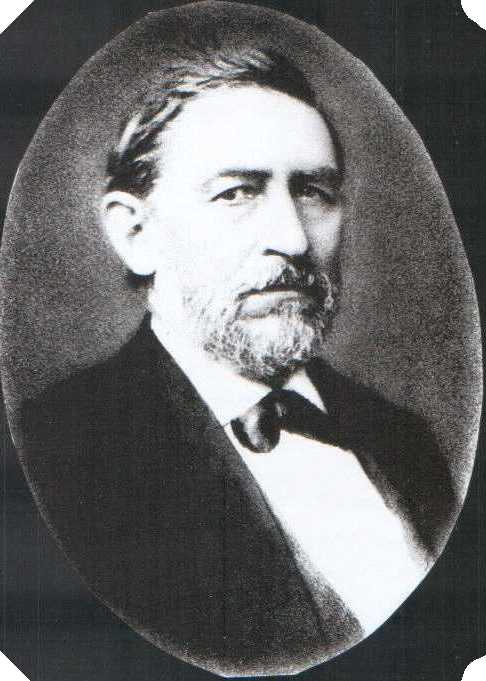
Peter E. Armstrong
--- the "mighty man of valor" who had the vision of Celestia
(1818-1887)
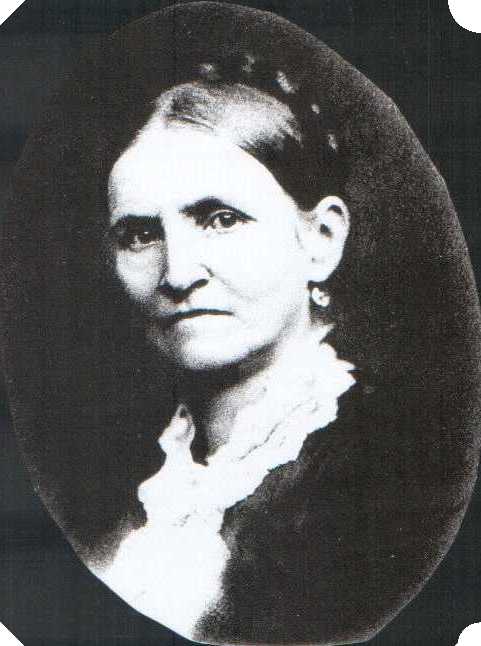
Hannah Taylor Armstrong
--- the energetic business woman and wife of Peter Armstrong
(1818-1893)
THE VISION: ARMSTRONG'S THEOLOGY
Armstrong decided that he would build a new city, pure from past sins, where Christ's second advent would take place. In 1850, Armstrong bought the land
(26) which would later become known as Celestia, or as many believed --- The New Jerusalem.(27) This "City of Heaven" or God's dwelling place,(28) was located on a high mountain top in the Endless Mountains of Sullivan County, Pennsylvania. The city was located between Laporte (the county seat since Sullivan County's formation in 1847 from Lycoming County) and Lewis Lake (now known as Eagles Mere --- a once thriving resort community).(29)In addition to his sense of vocation, Armstrong's complex theology is of great importance in understanding what he was trying to achieve at Celestia. The centrality of the theological issues emerges from numerous references to theology by Armstrong himself in a newpaper that he published at Celestia and also from several personal letters written to his friends.
(30) Although the actual evolution of Armstrong's ideal mission for Celestia is not fully ascertainable, his theology can be organized around four objectives which are enumerated in his newspaper, The Day Star of Zion and Banner of Life, which will be hereafter referred to as the Day Star.(31)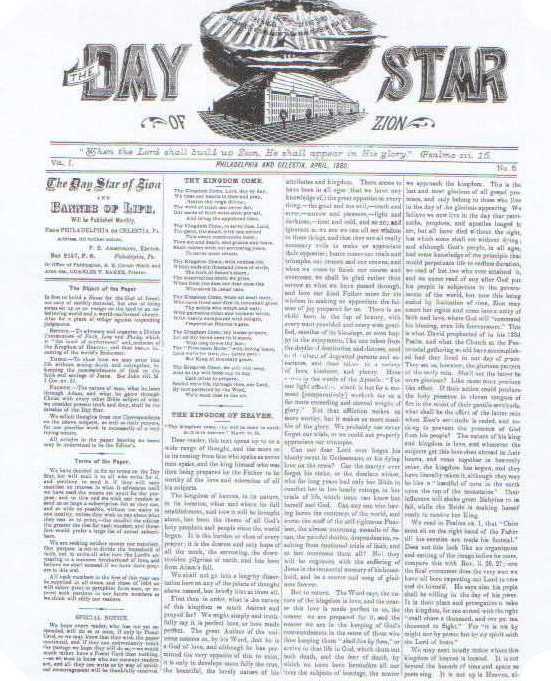
The front page of The Day Star of Zion and Banner of Life, No. 8.
The first objective was: "To build a 'House' for the God of Israel, not only of earthly material, but also of 'living stones' set up as an ensign on the land to an unbelieving world and a world-comformed church. Also for a place of refuge against impending judgments."(32)
In developing his beliefs and choosing the site for Celestia on a mountain top, it would seem that Armstrong was influenced by Zion theology. In the Old Testament, Zion is considered to be where Yahweh lives enthroned in his Temple.
(33) Since the fall of Jerusalem and the destruction of the Temple in 586 B.C., Yahweh did not have a permanent earthly residence. By his interpretation of scripture, Armstrong believed that the new Temple would be located on top of a mountain --- hence the location of Celestia. The text of Isaiah 2:2 may have reinforced this belief:(34) "And it shall come to pass in the last days that the mountain of the Lord's house shall be established in the top of the mountains." Editor's Note: Another influence not mentioned here by Bender was fifth century A. D. reform Christianity. Specifically, Saint Augustine, a North African critic of the sins and weaknesses of the late Roman Empire, wrote The City of God and other materials contrasting life in a true Christian "city" with the urban life he was familiar with.Further evidence that Armstrong thought of Celestia as Zion rests on the Psalmist's identification of Zion with the cosmic "mountain of God."
(35) Psalm 48: 1-2 provides the justification for this belief. "Great is the Lord and greatly to be praised in the city of our God, in the mountains of his holiness. Beautiful for situation [elevation], the joy of the whole earth, is mount Zion, on the sides of the north, the city of the great King." Armstrong also referred to the prophetic writings and determined that the house of the Lord was to be located "in the high place of a forest," "in the top of the mountains," "in the fields of a wood," and upon "a mountain of rocks."(36)Armstrong saw the fulfillment of the prophetic requirements at the site he had chosen for Celestia; however, he was not willing to equate the New Jerusalem with Celestia, or the last Temple with his Lord's 'House'.
(37) In his letters of 1884, Armstrong shared with a Brother Fisher his conviction that the proposed building of the Lord's House at Celestia "may be the ultimate standing place of the New Jerusalem, but of anything immediately connected with it I cannot see."(38) The same day (May 15, 1884) that this letter was written, Armstrong wrote to a Brother Hart and explained that he did not anticipate the realization of the New Jerusalem period for a thousand years; however, Armstrong did believe that while there would be no Temple during the period of the New Jerusalem, the world had now entered the millennial age which would have a sanctuary, according to scripture.(39) Armstrong dedicated his life to complete this sanctuary at Celestia, and he suggested that the headings of the Day Star in 1880 provided an accurate sketch of the proposed Temple.(40)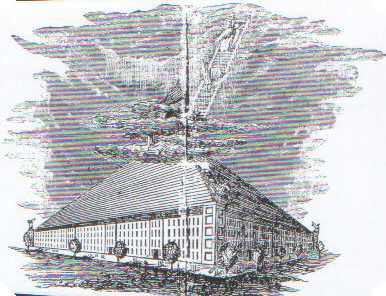
An unknown artist's concept of the Temple, according to the Day Star, No. 5.
According to the sketch, the actual structure would be a large four-story, square edifice with a high pyramidal roof leading to a tall tower, partially hidden in the clouds. In the earliest editions of the Day Star in 1880, there was a long stairway leading from the tower to an opening in the sky with two angels descending from heaven.(41) In the later editions the stairway was removed, but the prose of Psalm 34:7 was included: "The angel of the Lord encampeth around about them that fear him."(42) The tabernacle, which would have twelve symbolic entrances for the tribes of Israel, would be 340 feet square and cover an area of three acres.(43) According to Letter #4 of 1884, the tabernacle was to seat the 144,000 believers mentioned in Revelation, chapter seven.(44)
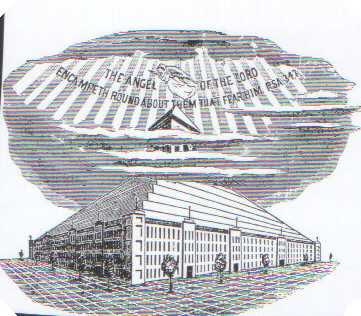
The Temple to be built at Celestia
with alterations from the original. This sketch is
according to the Day Star, No. 8 and No. 10
While Armstrong believed his Temple fit the scriptural specifications, he did not claim it was necessarily the Temple foretold by the prophets. In fact, he asserted that no Temple, past or present, could be the fulfillment of the prophetic Temple because they had all been desecrated by "the politics of the Roman beast," or in other words --- by man's involvement in the Church to gain his own desired ends. Nevertheless, Armstrong said his Temple would be the true House of God, located on a mountain top, visible to the world, and would not be defiled by human disobedience to the covenant.
(45) Although Armstrong was confident in his faith and would do everything in his power to accomplish his goal, he wrote that if the Temple at Celestia was not part of God's plan for the second advent then surely God would not permit the building of the Temple to take place.(46)Armstrong did not expect a universal gathering of believers at his Temple, but rather he hoped for a house that would attract people to Christ and the way to Zion so that they could "join themselves to the Lord in a perpetual covenant."
(47) It is this convenant relationship that was the basis for the second objective of Celestia, as set forth in the Day Star:"To advocate and organize a Divine Communism of 'Faith, Love and Purity' which is 'the bound of perfectness' and outburst of the Kingdom of Heaven; and thus hasten the coming of the world's Redeemer."
(48) Armstrong saw the need to organize a "Divine Communism" as a prerequisite for the coming of Elijah, who would usher in the last days. He based his belief on the ground taken by Brother Miller --- that the gentile times ended in 1843; and now there was nothing "further to fear, either Pope or Pagan, neither men nor devils, neither laws secular nor ecclesiastic."(49) Once the true believers were united in their belief, the King was sure to appear.In organizing this Divine Communism, which would be a complete theocracy, Armstrong did not believe in human law. Rather, at Celestia the people would follow the rule of God and seek such attributes as peace, meekness, and love.
(50) As long as this Divine Law was maintained Armstrong saw no need for governmental restrictions.(51)Armstrong was to "set up a theocracy at least on one spot of the earth's territory," and thereby allow his followers to become a "peculiar people" whose God was Yahweh alone. His theocracy was to be entirely separate from the secular world and the organized church, not being "recognized by any existing creed; it will not be received by any synod, council, or conference."
(52)Armstrong also believed that the Divine Communism would be the location of the Armageddon foretold in the scriptures. He wrote that human governments could never be converted by God; therefore his only recourse was to develop a "divine law and immediate government of God and keep our garments unspotted from the association of evil. . . ."
(53) Revelation 16:15-16 provided the justification for his belief: "Behold, I come as a thief. Blessed is he that watcheth, and keepeth his garments, lest he walk naked, and they see his shame. And he gathered them together into a place called in the Hebrew tongue --- Armageddon."The parallel drawn by Armstrong between Armageddon and Celestia is consistent with the purpose of his Temple. He had stated that the Temple would be a house of refuge during the last days in which the events of Armageddon would take place.
(54) Armageddon was to be the location of the last battle between good and evil in which great retribution would be directed toward the wicked.(55) Armstrong once described Celestia as "a place where no one who loves this life would love to live."(56) His statement seems to be in humorous contradiction to the third objective of Celestia: "To show how we may enter into life without seeing death and corruption, by keeping the commandments of God in the faith and sayings of Jesus."(57) This objective was an outgrowth of John 8:51 which states: "Verily, verily, I say unto you, if a man keep my sayings he shall never see death."(58) Since in Armstrong's mind eternal life and the Kingdom of God were equated, his third objective focused on the nature of the Kingdom.As a former Methodist, Armstrong had believed that the Kingdom of God would be in heaven. However, after the Great Disappointment, he agreed with the interpretations of Millerism that the Kingdom of God had already been established in heaven. Fulfillment of the words of the Lord's Prayer, "Thy Kingdom come," therefore meant that the Kingdom would be established on earth. He believed that the Kingdom would begin once a people truly received the love of God, and gathered in heavenly order under his Divine Communism. The fact that believers would sell their possessions and property and come to live at Celestia would be a sign of the coming Kingdom and a proof of the sincerity of their faith.
(59)Armstrong also believed that in order for this Kingdom of God to return to earth as it was in the Garden of Eden, a medium was needed to bring back the "tree of life." He believed this medium was a literal, tangible house of God or his proposed Temple. Armstrong wrote: "To this end let us arise and build up 'for the time to favor Zion, yea the set time has come.'
(60) Therefore, with the establishment of the Temple and the Divine Communism at Celestia surely the coming of the Lord was near, and those believers at Celestia would enter into eternal life without first seeing death.Armstrong concluded his discussion of the Kingdom of Heaven by stating:
This is the way, we believe, that the kingdom will be ushered in, and as the time is very near at hand, we have only to mark passing events, and watch and pray always, that we may be accounted worthy to escape all these things, that shall come to pass and stand before the son of man, and if we keep the word of his patience he will also keep us from all that is coming upon the world.(61)
The fourth and last objective stated in the Day Star is to be understood more as a goal of the newspaper rather than of Celestia in general. Nevertheless, it does provide some insight into Armstrong's image of himself as that "mighty man of valor". "The nature of man, what he loses through Adam, and what he gains through Christ, with every other Bible subject of what we consider present truth and duty, shall be the mission of the Day Star."
(62)In other words, Armstrong believed that the literary material that appeared in the Day Star could be considered authoritative --- second only to the words of Christ contained in the New Testament. This conclusion was based on II Peter 1:19, "we have a more sure word of prophecy; whereunto ye do well that ye take heed, as unto a light that shineth in a dark place, until the day dawn, and the day star arise in your hearts." By naming his newspaper The Day Star of Zion and Banner of Life, he asserted that the paper would be as a day star that arises in the morning and dispels the gloom of wickedness in the world. The paper would "be a light to gladden the hearts of those who have ears to hear and eyes to see."
(63) He further stated that when the true day star arises, which may be the faith of a single man or may be the community of believers at Celestia, then the controversy of Zion would be ended, for surely Christ would return.(64)Armstrong's four objectives functioned as theological and biblical guidelines for the historical development of his "citie on a hill." More broadly, the objectives witness to the persistence of religious impulses born in the ferment of early nineteenth century revivalism --- millennial expectation, utopian idealism, and perfectionism. In his thinking such impulses converged around a yet more basic theme in the history of religion in America --- the Puritan belief that God's destiny was to be fulfilled in the United States.
(65) As with the Puritans and nineteenth century idealists however, Armstrong's vision had to measure up to the stern realities of a "wilderness" not always congenial to dreamers.BEGINNINGS OF THE VISION
Born May 24, 1818, Armstrong was a native of Philadelphia where he probably heard the preaching of William Miller.(66) Together, he and his wife, Hannah, operated a paper store in Philadelphia where they raised the money necessary to come to Sullivan County.(67) Evidently, while Armstrong was traveling as a tinware vendor and a gatherer of rags for his paper business, he located the site for his Celestia.(68)Armstrong began to transform his vision to reality by purchasing 181 acres of land for his proposed city on September 27, 1850. After this first purchase along Pole Bridge Run for $450.00, Armstrong bought additional land in December and once again another 100 acres in 1860.
(69) Eventually, Armstrong was to own approximately six hundred acres of land in Laporte Township, Sullivan County.After Armstrong's original purchase in 1850, he began to lay out his divinely inspired city. From a copy of the city plan developed in 1852,
(70) one can easily see the parallel between Celestia and the city referred to in Revelation 21:16, "And the city lieth foursquare, and the length is as large as the breadth, and he measured the city with the reed, twelve thousand furlongs. The length and the breadth and the height of it are equal."The city was to contain eight residential blocks grouped around a center block which was marked "PUBLIC", and was understood as the Temple Square. The city blocks were divided by streets running east and west named Front, Second, Third, and Fourth; while the north-south bound streets were named Pine, Chestnut, Laurel, and Beech. At the center of each of these residential blocks (340 feet square) there was a smaller "PUBLIC" area of 140 feet by 100 feet to be used for purposes such as a park or community buildings. There were 44 lots to each block, with each lot measuring 100 feet by 20 feet. The first lot (number 44 of Block #8) was sold to Aaron I. Dietrick for $10.00 on December 21, 1852.
(71) Although this is the only sale of a lot recorded in the Sullivan County Deed Books, Magargle cites information that by February 28, 1853 there were 87 lots sold(72), and "The Sullivan Democrat", a Laporte newspaper, reported that there were over 300 lots sold by April 5, 1853.(73)Many of the people who were attracted to Celestia were from Philadelphia, and they usually purchased more than one of the unusually narrow lots of 20 feet.
(74) According to the Day Star of May 1880, the only prerequisites of those people who came to Celestia were "simply a humble and contrite heart, and a meek and quiet spirit."(75) Therefore membership was open to anyone who was willing to believe as Armstrong did.On the original city plan the name of Celestia was spelled as "Celesta." Magargle believes this to be an error in the spelling because the purpose of the city seems inconsistent with a celesta, a French musical instrument.
(76) However, when one examines the primary sources, it is only those primary sources written prior to 1865 that spell Celestia incorrectly. Primary sources after 1865 provide the spelling which suggest the celestial connotation to this heavenly city, while many secondary sources continue to spell the village incorrectly.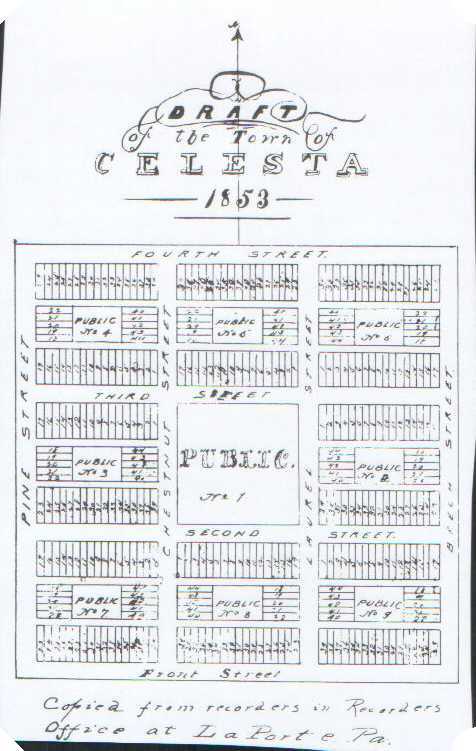
The city plan of Celestia as recorded in the Sullivan County deed records.
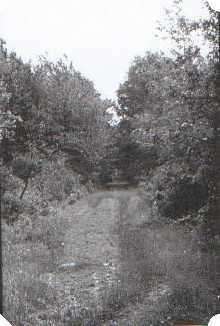
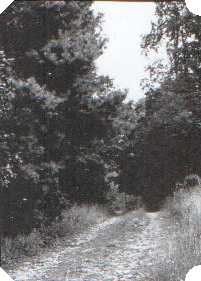
Left: Front Street looking toward Laporte.
Right: Pine Street looking toward Eagles Mere. It is along this road that most of the buildings were built.
1979 --- Lynne Miller.
Armstrong's acquisition of the land was the first step in the realization of his vision. However, Celestia was plagued with problems from the very beginning. The requirement of those who came to Celestia to have a sincere faith in heart and spirit later became a major difficulty for Armstrong. As Hannah Armstrong stated, many people came to live off the bounty of her husband and the community without the deeply committed faith.
(77) It is also uncertain how many people actually went to Celestia, or exactly how large the town became. One source claimed that over 1000 souls found shelter at Celestia.(78) This is certainly an exaggeration since, at most, there were only twelve structures ever built at Celestia. A fairly accurate description of the site is attainable by comparing several sources.There are no photographs of Celestia during its peak development, but there are three paintings which appear to depict the city accurately. One painting, which is owned by Armstrong's grandson, Mr. Robert Armstrong of Hughesville, was painted by Armstrong's son Michael Mylert Armstrong, at the age of sixteen.
(79) The painting is entitled "Celesta At Its Best by M. M. A."(80) The oil painting is crude in texture, but it clearly shows three large white homes, a large white barn, five smaller buildings which may have been small boarding homes, two smaller barns, a round springhouse, a pond, an orchard, a flock of sheep with one black sheep, and a herd of cattle.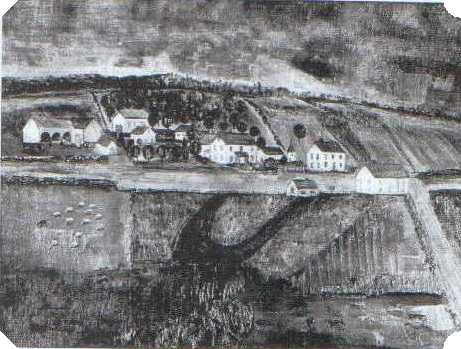
A photo of the reproduction of the original painting owned by Robert Armstrong entitled,
"Celesta At Its Best by M.M.A."
1979 --- Lynne Miller.
A second painting, similar to the first, at one time existed, but its location is unknown. This second painting is reported to have depicted a large brick kiln with several piles of bricks nearby. The bricks may indicate that the Temple had been started.
(81)Mrs. Guy Baldwin of Laporte, owns the third painting of Celestia. This painting was completed in 1849 by G. F. Armstrong,
(82) a grandson of Armstrong. Although he never lived at Celestia he investigated the history of Celestia and examined the old foundations of the town in order to do his paintings. After he completed the painting he showed it to his Aunt Lucy who had lived at Celestia. At her suggestion he made corrections, and the painting is now accepted as an accurate description of Celestia;(83) however, it was necessary for the artist to assume a hypothetical elevation and therefore the mountains in the background of the painting do not suggest the actual elevation of Celestia on the mountain top.From these paintings and from descriptive narratives in secondary sources one can see that the city never became more than a few buildings clustered near a small lake. The arrangement of those buildings show that they were not in accordance to the city plan. One source said it was "idle to attempt to apply the plan to the site as it may have been drawn before the site was selected and even by a Philadelphia draftsman who never visited the spot. . . ."
(84) At best, however, the structures at Celestia would have included five or six two-story houses of crude construction, the large Armstrong house, a blacksmith shop, and other small barns and outbuildings. It is possible that the buildings mentioned above were only temporary inasmuch as they were located near the southwest corner of the city plan, and therefore would be nearby during the process of clearing the land in preparation for building the actual city.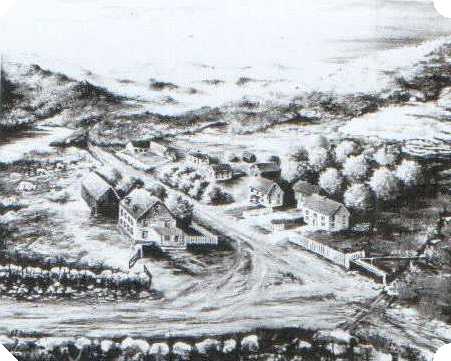
The painting owned by Mrs. Guy Baldwin of Laporte.
1979 --- Lynne Miller.
The Armstrong house actually was a large, two-story, combination store, printing office, and auditorium. On the first floor was the store which was operated by both Peter and Hannah Armstrong. The store had a reputation for good quality at moderate prices, and it drew trade from some distance. The success of the store was attributed to Hannah, who was a bright, energetic business woman.
(85) Sometime after May of 1880, a printing press was established on the first floor of the house. This may be surmised from the fact that, beginning with the Day Star of June, 1880 the publishing address for the newspaper was no longer listed as Philadelphia, but rather as "Celestia Box, Laporte."On the second floor of the Armstrong house was a large auditorium where meetings and church services were held. The weekly worship services, held on Saturday, were evidently conducted by a Reverend Mr. Curry rather than by Armstrong. The late William C. Mason of Laporte,
(86) recalled that once Rev. Curry and another adventist believer, Mr. Butler, fasted for forty days. Mr. Mason stated, "I believe that Mr. Curry did, as he was a perfect skeleton, but they say Brother Butler surreptitiously fed himself on blackberries and came through in fine shape."(87)According to Mr. Mason there was a pole on the roof of the auditorium from which flew a three foot triangular pennant. The pennant was white with large red letters on it that read "Y-A-V-A-H." Mr. Mason admitted he did not understand what the word meant; Wood, a local historian, explained that these letters referred to the incommunicable Hebrew name for the God of Israel which would be generally translated, "The Lord."
(88)The inhabitants of Celestia made a meager living from the profits of several economic endeavors. Some of the men were needed to work a large sawmill located along Pole Bridge Run, a mountain stream which was the outlet of the lake near Celestia and emptied into the Loyalsock Creek. Armstrong had built the sawmill in earliest stages of Celestia, and in 1857, he sold the mill to Peter Johnson, a nonadventist. Therefore, because the mill had independent ownership, the profits from the mill were minimal.
(89)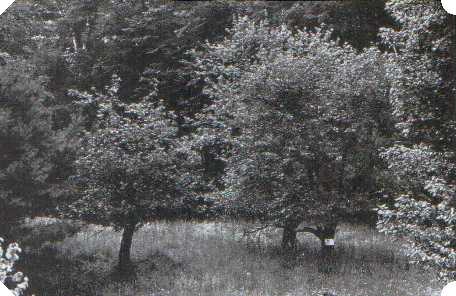
Three remaining trees of the apple orchard at Celestia.
1979 --- Lynne Miller.
The adventist believers also raised their own cattle, and at one time had a large flock of sheep. The wool harvest is claimed to have been the major source of income for Celestia.
(90) In early spring the inhabitants of Celestia were busy tapping maple trees and producing large quantities of maple syrup and sugar for shipment to Philadelphia the next summer. Mr. Mason claims that on occasion he saw several hundred pounds of maple sugar cakes piled up in a storehouse at Celestia awaiting shipment.(91) Over the years, a folk story has evolved with reference to the maple industry at Celestia.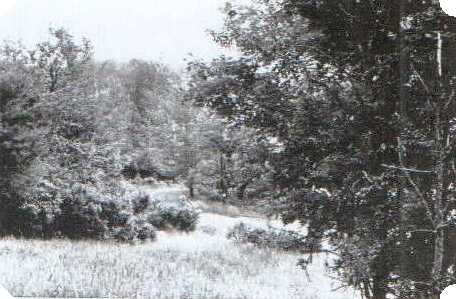
Photo taken from the orchard looking toward
the intersection of Front Street and Pine Street.
1979 --- Lynne Miller.
According to the story, Armstrong would often hew sap troughs on the Sabbath over the objections of his son, Peter Jr., who did not think this was proper observance of the Lord's day. Therefore, Peter Jr., devised a plan and hid in a hemlock tree under which Armstrong would often sit to hew the troughs. When Armstrong began to hew his troughs Peter Jr., shouted down with a deep voice, "Peter, what art thou doing?" Without replying, Armstrong looked around. Seeing no one, he went back to his work. Once again came the words "Peter, what art thou doing?", and confused Armstrong even more. But since he could not see his son because of the hemlock cover, he hesitantly proceeded with his work a second time. Now with even more power and emphasis Peter Jr. shouted, "Peter! What art thou doing?" By this time Armstrong had had enough, and thinking it was the Lord speaking to him, Armstrong cried out, "Hewing sap troughs, Lord." With that he threw down his knife and never worked on the Sabbath again.
(92)It is also a common belief that Celestia provided hemlock bark for the nearby tanneries in Laporte and Muncy Valley;
(93) however, no primary source suggests this source of income. All of the above economic enterprises, although energetically pursued, apparently did not provide sufficient income for Celestia to survive. Therefore, it was necessary for Armstrong to often return to Philadelphia to replenish funds in order to keep his vision alive.(94) One way Armstrong would gather funds was by selling more lots to prospective believers in Philadelphia.By 1860, Armstrong had finished the layout of Celestia, built his large combination home, store, and auditorium, and moved his family from Philadelphia to Celestia. Hannah and Peter had seven children: William, George, John, Alvah (A.T.), Michael Mylert, Mary and Lewis. Only Mary, born in 1856, and Lewis, born in 1859, were born at Celestia.
(95) A secondary source reported that Eva Kamm, the daughter of the only murderer hanged in Sullivan County, lived with the Armstrongs for several years.(96)The year 1864 proved to be a year both of rejoicing and trial. It was in this year that Armstrong first began to publish his newspaper, The Day Star of Zion and Banner of Life. Only four editions were published during that first year. Later in 1880, when publication of the Day Star resumed, Armstrong planned to reprint the first four numbers of 1864,
(97) but it is doubtful that he did. No copies are known to exist. The editions of 1880 attest to Armstrong's optimistic expectations for the newspaper: to communicate God's message and His intent for Celestia to all those throughout the nation,(98) to encourage believers to come to Celestia, to solicit funds for the Temple, and to be the community's authoritative literature --- second only to the Bible. As a result of the initial 1864 publications, Armstrong received increased financial support and also an increase in the number of people who came to his Divine Communism. Evidently the newspaper was discontinued later in 1864, because of the impending events which occurred that same year.OBSTACLES TO THE VISION:
Celestia VS. The United States Government
By 1864, the Civil War, which had long convulsed the nation, began to make its presence felt within the tiny utopian community. Sometime prior to March of 1864, an adventist believer living at Celestia, Mr. Charles Russell, was drafted to serve in the Union Army.
(99) This seemingly small incident was later to unleash a whole series of events which would change the whole character of Celestia.Armstrong understood Brother Russell's draft notice as both a test of the community's faith and as an opportunity to demonstrate its separation from worldly affairs, especially war. He wrote:
You know I have always contended that the times of the Gentiles expired by limitation of time about 1843, and it has been the privilege, if not the duty of God's people to separate themselves socially, religiously, and politically from the world, and thus prepare themselves for the coming of the heavenly King at any time since that period.(100)
Therefore, armed with such assurance, Armstrong immediately wrote to the President of the United States, Abraham Lincoln, asking that Russell be exempted from the draft.
(101) To give weight to his request, Armstrong had the Associate Judge of Sullivan County, James Deegan, and other county officials write a joint letter to the President stating that "we cheerfully recommend them [all the men of Celestia] as fit subjects for exemption from all war service."(102)However, before the letter from the County officials arrived in Washington, President Lincoln answered Armstrong's letter, granting his request for Russell's exemption from war service. Armstrong believed this speedy response by President Lincoln was due to the power of God which was contained in his letter to the President. He later wrote that this event was another sign attesting to God's purpose for Celestia, and how "it would be vain for man to oppose our work here" at Celestia.
(103)In order to gain further security from the draft, and also to relieve the financial burden of property taxes, Armstrong then had the State Representative of Sullivan County, Mr. George Jackson, introduce a most unusual petition to the state legislature.
(104) The petition, presented to the House of Representatives on March 7, 1864, asked that "God's people worshipping at Celesta, Sullivan County, praying for the passage of resolution that [they], while conforming to the faith they profess, be considered peaceable aliens and wilderness exiles from the rest of the Commonwealth of Pennsylvania."(105)Armstrong first sent the petition to George Jackson on February 29, 1864. In an adjoining letter Armstrong explained:
the course we are taking will bring a great blessing to this wilderness, both temporal and spiritual and [will] make little Sullivan a remarkable place in the old Commonwealth of Penna. We expect [to] gather 144,000, the "prophetical number," and who knows but that you may be one of the happy number. So if I am right or wrong, the character of the gathering will be such that nothing but good can result, to a place which has been hitherto called God forsaken by men of Worldly policy.(106)
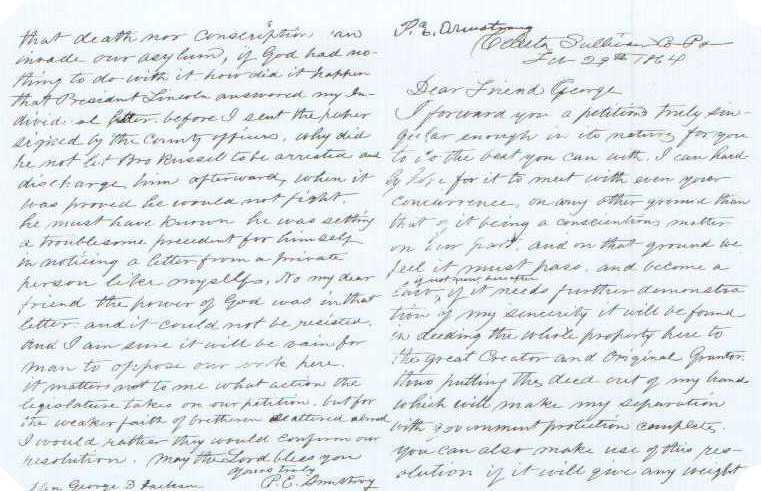
The first and fourth page of the Letter written to George D. Jackson from Peter E. Armstrong.
Note the references to Abraham Lincoln.
He further stated that it was important that the petition be passed because there was another large body of adventists (the Seventh-Day Adventists) watching the events at Celestia, and the petition's approval might cause the two adventist groups to unite in their common faith.
(107)The actual petition evidently no longer exists;
(108) however, Judge Thomas J. Ingham of Sullivan County, who wrote a history of Sullivan County during the 1800's, provides a detailed report regarding how the petition was presented in Harrisburg. He indicates that after the lengthy petition was read, Mr. Cochran of Philadelphia moved that it be referred to the committee on divorce. Jokingly, Mr. Alleman of Pittsburgh, suggested the petition should be referred to the "fancy committee" (the federal relations committee). Mr. Jackson then seriously asked that it be sent to the judiciary general committee, stating:They are a sect that have come (sic.) into the county of Sullivan, and have chosen a piece of land on the mountain tops. They are building a home for themselves. While I believe they are monomaniacs on this one point, they are good citizens of the county; they live sober and industrious lives and while I do not believe in their doctrines, I believe that they have a right, equally with the citizens of the commonwealth, to send their petitions to this house, and I hope that this memorial will be treated with respect.(109)
According to the minutes of the House, the petition, along with several others presented that day, was referred to the committee on the judiciary general.
(110)In a letter that appeared in the correspondance section in the Day Star in 1880, the next link of Celestia's history is given. The letter, from C. E. Stewart of Poultney, Vermont, asked several questions regarding the events that had taken place prior to 1875. Armstrong's response, dated January 10, 1875 from Philadelphia, provides the best understanding of the order of these events.
(111)Evidently, while Armstrong was waiting for a reply to his petition, which had been stalled in committee at the State House of Representatives, he decided he would state his cause to President Lincoln himself, since Lincoln had been so helpful when Brother Russell was drafted. Armstrong was granted an interview with President Lincoln; afterward the president wrote to Armstrong stating that he should present his case before the examining board of the district, so that it would be in official form to receive his consideration.
(112)Armstrong then explained to Mr. Stewart:
We did so; and when the board found we had taken the high ground of separation, geographically, to establish the kingdom of God, almost the first question was asked me if I held a deed to the property, and to be consistent with my profession, I must cancel my self-interest in it some way.(113)
Apparently, the examining board felt that it could evade Armstrong's request by presenting him with an impossible dilemma; either give up his land, or give up his faith.
Deeding the Land to God
Armstrong, however, was equal to the challenge set forth by the examining board. In a deed recorded June 14, 1864, Armstrong removed all earthly ownership of the land by deeding four square miles of land, of which Armstrong had redeemed 600 acres, to "Almighty God, who inhabiteth Eternity, and to His heirs in Jesus Messiah."
(114) As it turned out, the act of deeding the land to God was superfluous because before Armstrong had completed the transaction he received word from Washington that he had received entire exemption from the war.(115) According to Magargle, the approval came from President Lincoln himself, perhaps because he felt the men of Celestia would have made poor soldiers anyway.(116)This Indenture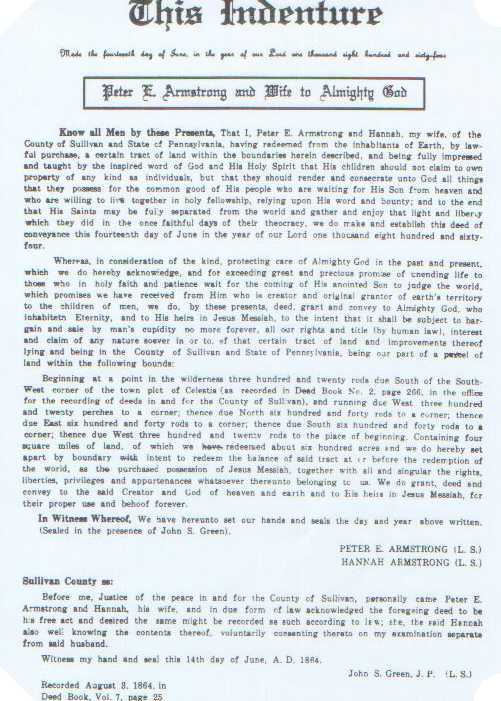
Made the fourteenth day of June, in the year of our Lord one thousand eight hundred and sixty-four
Peter E. Armstrong and Wife to Almighty God
Know all Men by these Presents, That I, Peter E. Armstrong and Hannah, my wife, of the County of Sullivan and State of Pennsylvania, having redeemed from the inhabitants of Earth, by lawful purchase, a certain tract of land within the boundaries herein described, and being fully impressed and taught by the inspired word of God and His Holy Spirit that His children should not claim to own property of any kind as individuals, but that they should render and consecrate unto God all things that they possess for the common good of His people who are waiting for His Son from heaven and who are willing to live together in holy fellowship, relying upon His word and bounty; and to the end that His Saints may be fully separated from the world and gather and enjoy that light and liberty which they did in the once faithful days of their theocracy, we do make and establish this deed of conveyance this fourteenth day of June in the year of our Lord one thousand eight hundred and sixty-four.Whereas, in consideration of the kind, protecting care of Almighty God in the past and present, which we do hereby acknowledge, and for exceeding great and precious promise of unending life to those who in holy faith and patience wait for the coming of His anointed Son to judge the world, which promises we have received from Him who is creator and original grantor of earth's territory to the children of men, we do, by these presents, deed, grant and convey to Almighty God, who inhabiteth Eternity, and to His heirs in Jesus Messiah, to the intent that it shall be subject to bargain and sale by man's cupidity no more forever, all our rights and title (by human law), interest and claim of any nature soever in or to, of that certain tract of land and improvements thereof lying and being in the County of Sullivan and State of Pennsylvania, being our part of a parcel of land within the following bounds:
Beginning at a point in the wilderness three hundred and twenty rods due South of the South West corner of the town plot of Celestia (as recorded in Deed Book No. 2, page 266, in the office for the recording of deeds in and for the County of Sullivan), and running due West three hundred and twenty perches to a corner; thence due North six hundred and forty rods to a corner; thence due East six hundred and forty rods to a corner; thence due South six hundred and forty rods to a corner; thence due West three hundred and twenty rods to the place of beginning. Containing four square miles of land, of which we have redeemed about six hundred acres and we do hereby set apart by boundary with intent to redeem the balance of said tract at or before the redemption of the world, as the purchased possession of Jesus Messiah, together with all and singular the rights, liberties, privileges and appurtenances whatsoever thereunto belonging to us. We do grant, deed and convey to the said Creator and God of heaven and earth and to His heirs in Jesus Messiah, for their proper use and behoof forever.
In Witness Whereof, We have hereunto set our hands and seals the day and year above written. (Sealed in the presence of John S. Green).
PETER E. ARMSTRONG (L.S.)
HANNAH ARMSTRONG (L. S.)
Sullivan County ss:
Before me, Justice of the peace in and for the County of Sullivan, personally came Peter E. Armstrong and Hannah, his wife, and in due form of law acknowledged the foregoing deed to be his free act and desired the same might be recorded as such accoring to law; she, the said Hannah also well knowing the contents thereof, voluntarily consenting thereto on my examination separate from said husband.
Witness my hand and seal this 14th day of June, A. D. 1864
John S. Green, J. P. (L.S.)
Recorded August 3, 1864, in
Deed Book, Vol. 7, page 25
Editor's Note: In July 2004, an original or an original "copy" of the indenture was posted on eBay and purchased by Bob Sweeney, the administrator for the Sullivan County Web site. Photographs of the handwritten indenture are shown at the top and bottom of this history. The very fragile original document was in a scrapbook recovered by Pat Andrews of Muncy, PA from a trash bin. She gave it to a friend, Jan Shoemaker also of Muncy. Here is what Jan had to say:
I have a friend, Pat Andrews, who works for an auctioneer..She gave me two scrapbooks(which obviously didn't sell at auction) that came from a family in Sullivan county. She knows I like to look at old "stuff". I had the scrapbooks for over a year before I really looked at them closely. I overlooked the deed the first time. I found the deed in one of the scrapbooks and decided to sell it on eBay. In the scrap book,there are some pictures from Sullivan county, lots of newspaper clippings from Tioga County and the surrounding areas. I don't know anything at all about the deed or how it got in there...sorry I am of no help to you. What makes this REALLY interesting is that I am sure that they were going to throw these scrapbooks away. As I think back, instead of an auction, I think Pat actually may have gotten it at a place where they take in charitable items for the needy (she volunteers there). They would have definitely thrown the books out if she had not taken and given them to me, Thanks again for sharing this story. Please keep me updated. I would love to see it someday displayed and it is neat to know I played a small role in its rediscovery. I am actually a nurse by profession. I've been interested in history and antiquities for some time now. Pat likes genealogy and history as well.
Nevertheless, the land remained deeded to the Almighty. This unusual disposition of land, which is today the most widely known aspect of Celestia, found proximate cause in the dilemma presented by the examining board, and remote cause in Armstrong's overall theology.
Armstrong, who always rooted his theology in scripture, may have been prompted to draft the unusual deed by Leviticus 25:23-24,(117) which reads: "The land shall not be sold for ever: for the land is mine; for ye are strangers and sojourners with me. And in all the land of your possession ye shall grant a redemption for the land."
The Armstrongs jointly deeded the land of [sic] God, stating that they believed in His protecting care, His promise of unending life to believers of the second advent, and His creation of the world. It is written within the deed that Peter E. Armstrong and wife "deed, grant and convey to Almighty God, who inhabiteth Eternity, and to His heirs in Jesus Messiah, to the intent that it shall be subject to bargain and sale by man's cupidity no more forever."(118)
By deeding the land to God, Armstrong assumed that the land would then be considered sacred, and therefore not subject to property taxes. The deed claimed that God's "children should not claim to own property of any kind as individuals, but that they should render and consecrate unto God all things that they possess for the common good of His people who are waiting for His Son from Heaven and who are willing to live together in holy fellowship."
(119) Such idealism is consistent with what Armstrong was trying desperately to accomplish at Celestia.Although, according to the deed, the land could never be sold again, the Armstrongs did make a provision as to how the land could be used. The deed gave possession, rights, liberties, privileges, and appurtenances of the land not only to Jesus Christ, the Messiah, but also to his heirs.
(120) Therefore, anyone who believed in Christ and could be called a Christian could be classified his heir and had access to the land.By such action Armstrong believed that he had protected his followers from the evil of this world (e.g. the Civil War), and also established his own faith and integrity of purpose.
(121) Further, he could thereby deny any self-interest in Celestia and he could devote his time to be an "instrument of God's will" for the believers of the second advent living at Celestia.(122)It should be noted that Armstrong only deeded that land known as Celestia to God. By that time, Armstrong did own other land in Laporte Township, but he kept this land in his personal possession with the intent that the land could be so sold for the benefit of Celestia, if in the future it became necessary.
(123)Unbelievers Force Development of Glen Sharon
Little is known about Celestia from 1865 to 1872. The Day Star had stopped publication after only four editions in 1864, and thereby Armstrong lost a vital source for encouraging new believers to come to Celestia. It probably stopped publication because of the high expense of having it printed in Philadelphie, and also because only a few subscriptions were received. Therefore, the turmoil of these developmental years of Celestia can at best be reconstructed from a few references in the Day Star after it resumed publication in 1880.
A paragraph in the January edition of the 1880 Day Star, written by Armstrong,
(124) indicates the persistence of Armstrong's idealism during this period.There is no greater mistake than to suppose that Christians can impress the world by agreeing with it. No; it is not conformity that we want, it is [not] being able to beat the world in its own way; but it is to stand apart and above it, and to produce the impression of a holy and separate life --- this only can give us a true Christian power.(125)
Such idealism, however was not matched by the recruits of Celestia. After 1864, people were still coming to Celestia, but not because of their religious faith. Such people saw Celestia as a shelter from society, a place where they could avoid the draft and taxation. Life became easy for these people as they lived off the goodness of the community and Armstrong, knowing that their basic needs of food and shelter would be taken care of.
(126) Armstrong's reaction to such tepidity was mixed:Father (God) suffered a class of people that so alienated my family [those believers at Celestia] from the work that I felt it my duty to take them away . . . . People did not stop coming there when the Day Star stopped and common interest ceased. I had worse cases afterward than before. Perhaps I did wrong in lowering the standard but it seemed to me that such a course could not exist when people could bring their own wives and children without let or hindrance and while my own were in partial unbelief I had no right to dictate conditions to others.(127)
It was, then, not only the difficulty in caring for the unbelievers at Celestia, but also the fact that Armstrong's own family was in partial disbelief that made it especially difficult for Armstrong to evict the unbelievers. Even Armstrong's wife did not completely agree with her husband on some points of his religious doctrines, although she did, in general, support his work. Of Armstrong's children, George supported his father the most, but his faith was only temporary.
(128)The burden placed upon Armstrong by the presence of unbelievers in his Divine Communism almost caused the collapse of Celestia. To salvage his dream Armstrong devised plans for a second village which would be probationary in nature. Here, those who wished to live at Celestia would first live and prove the sincerity of their faith, and then move on to Celestia where the true holy fellowship would be.
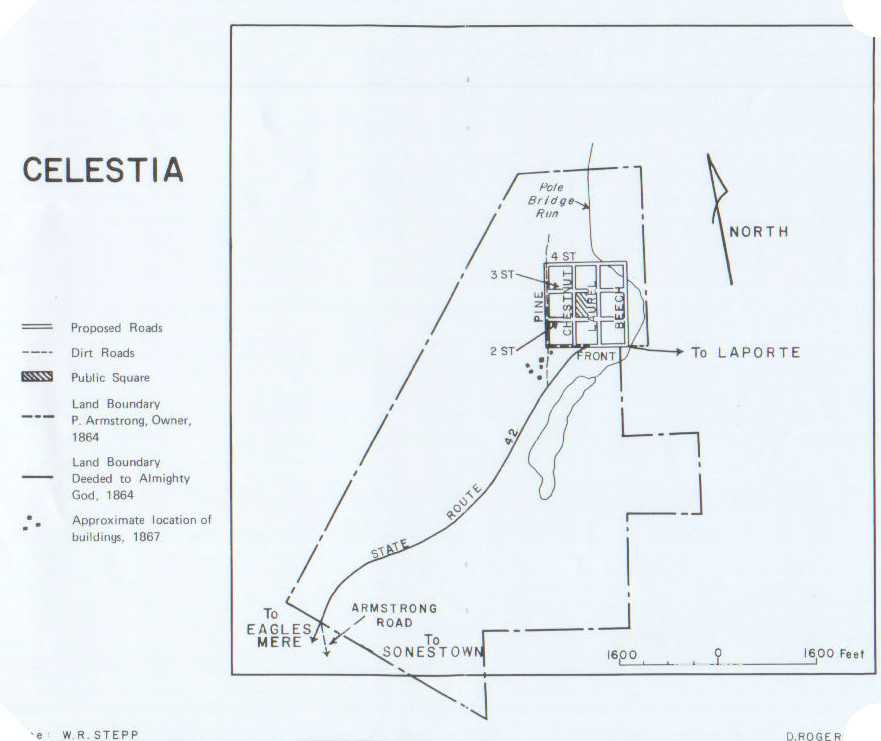
In 1872, Armstrong bought the land which would be the future site of his second village --- Glen Sharon.
(129) The land, bought in two segments, was in Davidson Township, Sullivan County, one mile south of Sonestown. On July 10, 1872, Armstrong bought 10 acres and 146 perches of land from John Philips for $282.81.(130) The second purchase was on December 20, 1872, with an additional 67 acres and 112 perches sold by John and Suzannah Hazen for $3000.00.(131) It is also known that sometime between 1865 and 1872, Armstrong had returned to Philadelphia,(132) and it is during this time that he may have continued his paper business so that he could gather funds for the purchase of this land.Glen Sharon was situated in the valley at the foot of the mountain on which Celestia was located (approximately six miles away from Celestia). It is also during these intervening years that Armstrong probably built the road connecting Celestia with Sonestown, which is now, though only a mountain path, known as Armstrong's Road. The major reason for choosing this valley for his town was because he expected the Williamsport and North Branch Railroad to be completed through the valley in a few years, and this would provide easy transportation for believers to come to Celestia.
(133) Another possible reason for choosing the valley site for his second town was because the long, narrow valley reportedly reminded him of the field of Sharon in Canaan, and hence the name --- Glen Sharon.(134)Although there was not an official plan for Glen Sharon as there was for Celestia, much can be reconstructed about the layout of the village.
(135) The main street of Glen Sharon was Park Avenue which ran perpendicular to the main highway (Route 220) and the Muncy Creek. It was probably the main highway that was known as First Street.(136) The next street that crossed Park Avenue was Sharon Street,(137) and running along the creek was Mill Street. These streets, however, were probably nothing more than grass paths which led to the homes away from Park Avenue.(138)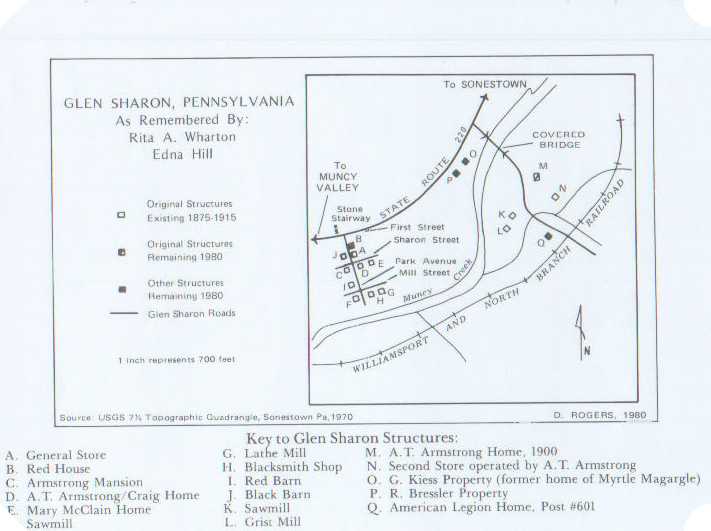
According to the informants (Rita Wharton and Edna Hill) the buildings of Glen Sharon included a large general store operated by Armstrong's son, Alvah T. Armstrong; the "Red House", a two-story structure with four rooms; the "Mansion", a large 17 room structure owned by Armstrong, with a large room probably used for town meetings and religious gatherings; the home of A. T. Armstrong, later owned by John and Mary Craig, Armstrong's daughter; the Mary McClain residence; a sawmill; a lathe mill; a blacksmith shop; a large red barn located near the creek; and the "Black Barn" located across from the Red House.
(139) Opposite Park Avenue there was a stone stairway which led up the side of the mountain. It is reported that each morning Armstrong would ascend these stairs to pray.(140)Across the Muncy Creek, near the present Legion Home of Post 601, there was a sawmill and a grist mill operated by the residents of Glen Sharon.
(141) The location of the mill pond and the foundations of the sawmill are still visible. A. T. Armstrong later built a large home near the sawmill, just across the covered bridge, and moved his family there in 1900.(142) Eventually he was to build a second store near his home, which is still remembered by many in the nearby communities. One story refers to when A. T. found a dead cat in the pickle barrel and yet continued selling the pickles.(143)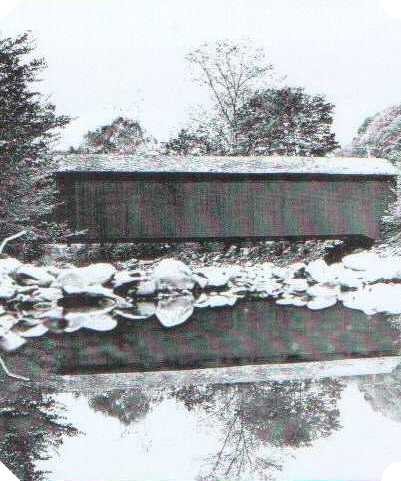
The Sonestown Covered bridge, built in ca. 1869,
which connected Glen Sharon with a sawmill
and grist mill on
the opposite side of the Muncy Creek.
1980---McGuire Photo
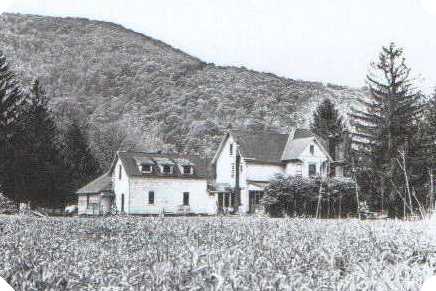
A view of the A. T. Armstrong home built in 1900.
It is located across the covered bridge.
1980---McGuire Photo
Armstrong summarized the events regarding Glen Sharon when he wrote in the Day Star of January, 1880:
I want to see a prepared people, but the preparation must be made outside. There are no more families with all their fleshly idols going to Celestia with my consent; but any humble Christian, of a family that thinks there is a possibility of my faith being right, and wants a home at the foot of the mountain, I will help them to one, and if they want to go higher, they can give or sell to some one else of weaker faith, and so on until "saviors go up on the mount of Zion, and judge the mount of Esau; and the kingdom be the Lord's" (Obadiah 1:21).(144)
The Obstinate Miss McClain
From 1872-1880, therefore Glen Sharon was developed as a proving ground for potential residents of Celestia. One believer, Mary McClain, from Iowa, had heard of Celestia through the Day Star, and evidently she was so moved by the faith Armstrong demonstrated in the paper that she sent her life's savings to him for use at Celestia. Miss McClain, who had been a nurse during the Civil War, subsequently decided to come to Celestia and to be a school teacher for the many children living there.
(145)With the money ($850.00) Miss McClain sent him, Armstrong bought 140 acres of land in Laporte Township August 7, 1873.
(146) Evidently, when Miss McClain arrived at Celestia she was not pleased with the wilderness she had bought. Furthermore, there were not enough children for a school. As a result she asked for her money to be returned so that she could leave, but Armstrong refused.(147) Apparently the argument that followed was settled on July 18, 1874; the county deed records show that Miss McClain bought a one-acre lot in Glen Sharon for $1.00 with the stipulation that Armstrong would build her a home according to her specifications.(148)Trapped in Glen Sharon, Miss McClain then invested her life and her meagre earnings to operate a small millinery shop in her home. There she made and sold low-priced women's hats and drew trade from a wide area. As a strong prohibitionist, she bought tracts and picture cards to give to adults and children to discourage their use of alchohol and tobacco.
(149)In a scrap book that Miss McClain kept,
(150) there is a letter to the editor describing Glen Sharon through the eyes of an artist who would want to capture the beauty of the changing seasons on canvas.(151) Seemingly Miss McClain was pleased with Glen Sharon which boasted a "Store, turning mill, sawmill, blacksmith shop, and four dwelling houses" and also the grist mill and three more houses across the creek. Her references to Armstrong were positive; she pointed out the hard work Armstrong had done and continued to do. Miss McClain was also comforted by Armstrong's ruling that only moral men could have their residence in Glen Sharon(152)Miss McClain's approbation, however, was only fleeting. According to Magargle, Miss McClain later became a "thorn in the flesh" to Armstrong. Since she felt she had been tricked into coming to Celestia, she felt it was her duty to warn others about the truth of Armstrong's goals. She did so by writing to city newspapers and telling how she had been decoyed into going to Celestia, how Armstrong would not return her money, and therefore, how she was unable to leave. She also claimed there had been no attempt to build the Temple although $1000.00 had been contributed. She claimed Celestia was being falsely advertised and that many people were leaving the little "hamlet." She even went so far as to say that Armstrong, "the Prophet," was keeping a servant maid as a "strumpet."
(153)Needless to say, Armstrong's reaction to the letter was vigorous, and he confronted Miss McClain openly about her accusations. Miss McClain stood her ground, and rather than withdraw her statements she repeated her accusations to him.
(154)A later letter by Miss McClain repeats and amplifies many of these same accusations:
When the town was being built we were told by the proprietors it was to be settled by a moral, intelligent, religious people, which we did not in the least doubt, as the head proprietor had a few years previous we were told, deeded a part of his land to the Lord, and since has dug the foundation for a religious temple for the good to worship in when the dregs of earth are done away with.(155)
Miss McClain doubted Armstrong would ever accomplish his desired end because, as she atated, "For he who cannot his word with woman keep, cannot hold faith with God."
(156)As if the problems with Miss McClain were not enough, sometime around 1876, the Sullivan County Treasurer, Walter Spencer, began to demand payment of the back taxes due on the property deeded to God.
(157) At this point in Celestia's history the actual order of the events is uncertain since no primary source provides the needed information and secondary sources disagree.According to secondary sources the county tax collector came to Celestia and when Armstrong refused to pay the taxes because he believed the land was sacred and tax free, the county tax collector had the sheriff return to Celestia and drive off a flock of sheep in lieu of the taxes.
(158) As legend has it, when the sheriff came to take the sheep, Armstrong gathered his followers together to witness a miracle. He claimed the sheep would not follow the sheriff across the bridge. But the sheep did follow the sheriff, and as they disappeared over the bridge many of Armstrong's disciples did likewise.(159) It is this story that has often been used to explain the eventual fall of Celestia.According to a newspaper article that appeared in 1931 the sequence of events was different: the County Treasurer, Walter Spencer, not having received the back taxes, sold 350 acres of the property at a Sheriff's Land Sale.
(160) At the sale, Armstrong's son, A. T. Armstrong, bought the property for $33.72 costs, which included $30.10 for the taxes.(161) It is reported that when A. T. bought the property he explained that he in no way intended to represent the rightful owner (God) by buying the land.(162) County deed records do not mention the tax sale since the treasurer's deeds were not recorded at that time; therefore no further record of the deed is mentioned after the transfer from Peter Armstrong to Almighty God.(163)Nothing is certain with regard to the tax sale except that the sale was held and that A. T. Armstrong became the owner of the land. Assuming the year of the sale is correct (1876), and that A. T. bought the land at this time, it is plausible that Armstrong could have still remained on the "sacred" land and kept his vision alive without interference from his son, the owner of Celestia.
ARMSTRONG'S VISION RENEWED
The Day Star and The Temple
All was not lost. While Armstrong was still building Glen Sharon and dealing with the problems caused by Miss McClain and the county treasurer, he was given a new understanding of his vision. It was in September of 1877 that Armstrong, for the first time, realized he was actually to build the Temple that has previously been described.
(164) The idea of the Temple gave his faith new strength, and he began to prepare the foundation which Miss McClain referred to in her letter. Before he was able to continue construction, however, he had to leave Celestia for Philadelphia and Florida.(165)The reasons for Armstrong's departure can only be surmised. Possibly he went to Florida because his son, John, died there of yellow fever in 1877.
(166) At this time John Armstrong's children may have returned to Glen Sharon with their grandfather, for it is known that A. T. Armstrong raised John's children at Glen Sharon after his death.(167) Armstrong may have also returned to Philadelphia in order to replenish funds necessary to begin the Temple construction.However, Armstrong returned to Sullivan County with his vision renewed. With the development of Glen Sharon, Armstrong had solved one problem. With the passage of time and with his new incentive, the problems caused by Miss McClain were lessened, although the "thorn in the flesh" was still present. The Divine Communism, Armstrong believed, was once again being established as a purified and separate people preparing for the second advent of the Lord.
In January of 1880, The Day Star of Zion and Banner of Life resumed its publication on a monthly basis. The only editions which are known to exist are January - #5, April - #8, and June - #10. These editions and the article by Kenneth Wood who used the now lost May edition (#9) are important primary sources for this period of Celestia's history.
According to the January edition the first four editions which had been published in 1864 carried topics including the conscription case (the draft situation), the interview with President Lincoln, the exemption from the war, a biography of Armstrong, and the deed of conveyance to God. It was also mentioned that in 1880 these editions were to be republished in pamphlet form.
(168) This goal was probably never achieved, and as of June 18, 1884 they had not yet been published.(169)It had been reported by the "New York American" magazine that the Day Star periodically would announce the date of the second coming of Christ.
(170) This is quite improbable since it would be inconsistent with Armstrong's statement concerning his displeasure at the fixing of dates by the Millerites, and also by the fact that no dates were given in those editions still available.Previous histories of Celestia ended after the events of 1880 which were reported in the Day Star. However, the newly found Letters of 1884 illuminate subsequent events which provide the continuation of Celestia's history. Armstrong evidently kept his faith and continued to prepare to build the Temple even though he had met several discouragements along the way. He wrote, "I never fully understood till now [May 15, 1884] the meaning of the word 'many shall be purified, made white and tried.' If I have not been tried in this Celestia movement I fail to understand the import of the language."
(171)Prior to 1884, Armstrong had spent his summers of 1882 and 1883 at Celestia making improvements on the grounds. After the improvements were made, he renewed his invitation to others to come to Celestia.
(172) He wrote to many friends, those who had formerly lived at Celestia and had moved away for good reasons and also to those who were believers though they had never come to Celestia, and invited them to come and witness the laying of the foundation stone of the Temple.Armstrong was very optimistic that "the set time to favor Zion has arrived" and he pleaded with his followers not to lose their faith when they were so near their reward.
(173) Armstrong believed that 1884 was now the last year of the 2300 year period when the cleansing of the sanctuary was to occur.(174) And now on the "tenth day of the seventh month" the center foundation stone of a clean sanctuary would be laid on the land dedicated to God.(175)The foundation stone, which was to be "cut out of the mountain without hands" (Daniel 2:45), was located by Armstrong about nine miles from Celestia. He described it as, "very peculiar and apparently cut from two others which lie at either side; it is of immense proportions, but I have said that it fills the prophecy literally,
(176) it is bound to come here by the 10th day of the 7th month."(177) It was Armstrong's plan that twelve men would lay the foundation stone(178) on October 27, 1884, the date Armstrong believed to be the Roman calendar equivalent to the tenth day of the seventh month Jewish time.(179)Armstrong described his preparation for the laying of the foundation stone:
We have been busy for three seasons preparing what scripturally seems the garden of the Lord --- it lies directly in front of the Temple lot, and is about one mile in extent, a crystal stream runs through the middle of it, over pure white sand and clay of various colors; we have straightened the stream to a uniform width of twelve feet for over a half mile, at which point it branches off in two streams each of which flow over level ground for a half mile further. Celestia literally lies on the side of the north. It is all shut in by an evergreen wilderness, but you can see the north as far as your eye can reach over a vast stretch of forest and mountains.(180)
In that same letter Armstrong continued his description of the land by stating that he had been beautifying a boiling sand spring the last three days, and that he had dug a circle around the spring (60 feet in diameter). This circle was the perimeter for a walk that was 12 feet wide that enclosed the spring. He then planted two rows of evergreen trees around the walk. He planned to fill the spring with brown trout from the nearby streams. Such effort was explained in scriptural terms: "I will beautify the place of my sanctuary."
(181)Armstrong was excited about his accomplishments and with strengthened faith he repurchased the same printing press, for $100.00, that he had sold for $200.00 in 1881. He also planned to resume the publication of the Day Star with edition #12,
(182) and once again expected that the republication of the first four numbers would be done shortly.(183)The Letters of 1884 end abruptly with the extremely optimistic letter of July 18, 1884. It is not known if the foundation stone was ever laid, or if people ever returned to witness the event. It is very doubtful that the Day Star actually resumed publication, since no further editions are ever mentioned or known to exist. However, it is clear that Armstrong's optimism was not sustained through the later events of that year.
DENOUEMENT
The exact reasons for the decline of Celestia are unknown and remain a mystery; however, Armstrong has provided a few clues as to the final days of his vision.
Armstrong wrote on May 31, 1884 to a Brother Ney that after he had broken ground for the Temple in 1877, and after the prosperous year of 1880, there came a "strange dispensation of providence" which called him away from his work on the Temple until the summer of 1884.
(184) No further explanation of those "strange" events was given. However, in another letter of June 1, 1884, a possible link is provided.Armstrong wrote that prior to the year 1881, he had been greatly tried by a visionary, Mr. Giddings. This man, who remained at Celestia longer than any other visionary
(185) began to strain Armstrong's patience. His departure was a welcome but short-lived relief for Armstrong, because that very same day another visionary ("A Sunday Man") arrived and stayed for two months. After this Armstrong "was so discouraged that [he] ceased to publish the paper waiting for the Lord to clear away all such obstacles."(186) At this time it seems Armstrong returned to Philadelphia with Hannah and his daughter, Mary (who had married John Craig and now had two children).(187) While living in Philadelphia he wrote several articles for other adventist publications, such as "The Sabbath Advocate" and "The Crisis". However, they often refused to publish his articles.(188)The discontinuation of the Day Star from 1881 to 1884 was surely part of Celestia's downfall. Armstrong realized the importance of the paper for keeping his faith alive, and he tried desperately to resume publication by July of 1884.
(189) It is doubtful that the Day Star ever went to press again, and with its failure, Armstrong lost his major source for attracting believers to Celestia and for soliciting funds for the Temple.(190) In the years following 1880, only a few faithful believers remained at Celestia. It would seem that during these years Armstrong renewed his private determination to complete construction of the Temple seven years from the date he prepared its lot in 1884.(191) Nevertheless, his determination was not enough. Valiant attempts to encourage people to return to Celestia in 1884 for the laying of the center foundation stone was his "last ditch" of hope(192) and probably ended fruitlessly. Armstrong was also getting older, and he could no longer provide the active leadership and charisma that was necessary for Celestia's survival.The problem of Armstrong's increasing age caused discontent among the believers at Celestia. What if Armstrong were to die? Who would provide the necessary leadership for the community? His sons? Hannah?
(193) Armstrong even admitted his wife's lack of faith, but claimed his children were waiting for some demonstration before they would be believers.(194) Yet it was clear that Armstrong's family would not continue his vision for Celestia. The realization of the dreams for the city on the hill clearly demanded the presence of Armstrong himself. At the same time, Armstrong's inability to transform his vision to reality led other followers to question the authenticity of their own faith.Armstrong had written that he was an old '43-'44 Adventist and that he was still sure of the faith he had received 40 years before.
(195) However, he did admit on July 18, 1884, that if he could not prove his faith by a demonstration (laying the foundation stone of the Temple) by the end of 1884, then he would be willing to listen to other views regarding the return of Christ(196) In the meantime, he hoped that the Seventh-Day Adventist folks at Battle Creek would join his Celestia movement after he proved his faith in 1884.(197)It is apparent that the events Armstrong had desperately hoped for at Celestia did not take place, and the Seventh-Day Adventists did not join Armstrong in his beliefs. It would seem that the light of that "bright celestial star" which once described Celestia was fading out.
(198) But how was the history of Celestia to finally end?Celestia
Shine on thou bright celestial star
Let thy pure beams glance out afar
With generous and fervid glow,
Dispelling darkness, sin and woe.
The gospel-banner is unfurled,
A beacon light to all the world,
To guide the erring to the way
That leads to heaven's eternal day.
To beckon pilgrims ever on
Until life's victory is won;
To urge them upward to the goal,
The hope of every ransomed soul
And wean them from this earthly sod,
To wait the coming of their God.
Blessed be thy place where all may rest,
Who wear the armor of the blest.
And blessed be those Christians too,
That number with thy faithful few.
Oh! rich will be their sweet reward
In the soon coming of our Lord.
Thy Day Star, like a carrier dove,
Has proved a messenger of love.
May e'er its faith, hope, truth and right,
Spring upward from thy living fount,
Oh! fair Celestia of the mount.
EPILOGUE
Ironically Armstrong died at Celestia. Although it had been his dream to see the Lord face to face at Celestia and enter into eternal life without experiencing death, he did "meet the Lord" at Celestia on June 20, 1887, at the age of 69. [Editor's Note: See his obituary posted just below.]
(199) With his death the dream of Celestia became only a memory. Armstrong was buried in Philadelphia, where Hannah continued to live with her children; however, she often returned to Glen Sharon and Celestia to renew past friendships, visit with family, and recall her pleasant memories.(200) Hannah died on April 23, 1893, at the age of 74.(201)
Dushore, PA
June 24, 1887
Peter E. Armstrong died suddenly at Celestia on Monday morning. He rose as usual and went out to work breaking stones. He had not worked long when he quit saying that he was short of breath and could not stand it.
He then went a short distance to where Chas. Thorp was working at a ditch, and seeing Mr. Morgan of Shrewsbury twp. Coming along the road asked who that was coming. These were his last words. He fell and before help could reach him rolled into the ditch. He was taken up and carried to his house, but was unconscious and life was extinct in a short time. It is believed that his death was from apoplexy.
Mr. Armstrong was about 70 years of age. He purchased the land now known as Celestia in 1852, and laid out a town there. Soon after he brought his family from Philadelphia and resided there for a few years. He then returned to Philadelphia with his family and resumed business in that city. Several years ago he retired from business in the city and since that time has spent a portion of each summer at Celestia and recently has made considerable improvement there.
Two of his sons were telephoned for, and came as soon as possible after his death. The body was taken to Philadelphia for interment as Mr. Armstrong and most of his family reside there. Mr. Armstrong was widely known and highly respected, and his sudden death will be sincerely mourned.
We have but little knowledge of his early life, but he was a man of education and intelligence, and a good businessman. He was a man of exemplary habits trustworthy and honest in his dealings. He was an attentive student of the Holy Scriptures and had many passages at his command to quote in sustaining his views. He was a firm believer in Christianity, but differed much in many respects from other denominations. That he was sincere in his belief and lived according to it no one can doubt.
His friends and neighbors sincerely mourn his loss.
Most of the disciples had left Celestia, but Charles Thorp and his family are reported to have remained at Celestia for several years. Also, Mr. Andrew Jenkins lived at Celestia while he continued to work in Eagles Mere.(202) It is reported that when "Old Jenkins," died, over $3,000.00 was found in his home. "Old Jenkins," who had been Armstrong's right hand man, had stated prior to his death that the money was for the Lord's personal use when he returned to earth.(203) The remaining homes of Celestia were used on occasion by migrant workers and those who had worked on the nearby sawmills and in the popular resorts at Eagles Mere.(204)
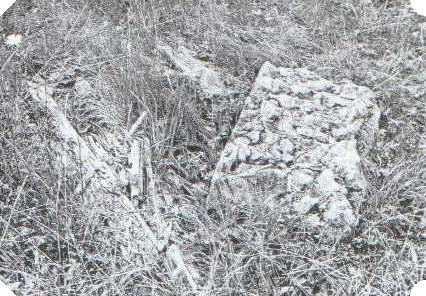
A portion of an old foundation at Celestia.
1979---Lynne Miller.
Margargle reported a folk story that the people of Eagles Mere often shared with their tourists. It seems that when prospective believers and visitors were scheduled to arrive at Celestia, Armstrong would send a believer to place loaves of bread in the forest. Once the unsuspecting visitors would arrive, Armstrong would tell them of the desperate needs of the community, and then prove his faith and power by praying that stones would be turned into bread. Then during their visit the loaves of bread would be found and the visitors would be so impressed that they would often make a generous contribution toward the work of Celestia.(205)
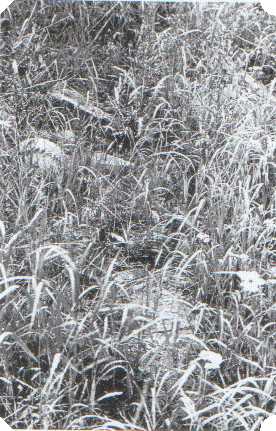
A foundation wall visible through the high grass.
This foundation is believed to be part of
the Armstrong home in Celestia.
1979---Lynne Miller.
At the foot of the mountain, Glen Sharon continued its existence until 1915. In a deed dated November 15, 1915, the descendents and heirs of Peter E. Armstrong as well as the residents of Glen Sharon released all the property of the village to A. T. Armstrong, who had continued to run a general store in the village after his father's death.(206) During the 1920's, Clyde Sheets of Sonestown bought the property, and he tore down the village (except for the "Red House") to make room for a farm. The lumber from these homes was then used in building the community hall in Sonestown, which was later remodeled into the present gymnasium of the Sullivan Highland School.(207)
All that remains within the actual site of Glen Sharon is the "Red House", which is now the present home of Mrs. Jane Sheets, and whose driveway was once Park Avenue.
(208) During August of 1979, the stone stairway, used by Peter Armstrong as a pathway to his prayer sanctuary, was uncovered by Mr. James St. Clair and the author. The stairway lies approximately 100 yards south of Glen Sharon. Over the years it has been badly damaged by the building of the present highway and also by the logging industry. The stairway is very natural looking, yet obviously cut purposely into the existing shale rock. The section of stairway which remains contains twelve steps, ranging from four inches to eight inches in height per step.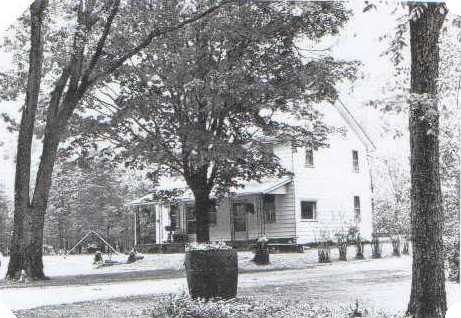
The "Red House" of Glen Sharon
looking scross Park Avenue (the driveway).
Now the home of Jane Sheets.
1980---McGuire Photo
Across the Muncy Creek from Glen Sharon proper, the large home that A. T. Armstrong built in 1900 still stands and is the present home of Mr. Russell Quava. Along the stream, near the site of the sawmill and the grist mill, the race which once powered the mills is still visible, and also one foundation wall of the sawmill. The store that A. T. Armstrong built and operated on this side of the creek is now a horse barn built upon the old foundation of the store.
(209)Mary McClain died of pneumonia on February 13, 1899, while living at Glen Sharon.
(210) During the last days of her illness she lived with A. T. and Ocy Armstrong in Glen Sharon.(211) It is said that the minister used the text of II Timothy 4:7 for her funeral message, "I have fought a good fight, I have finished the race, I have kept the faith."(212) She was buried at the old Sonestown Methodist cemetery, although no stone marks her grave. The sale of her home and possessions totaled $219.03, an amount insufficient to cover the $260.00 in back taxes on her property. The deficit was paid by Ocy Armstrong, the administratrix for the estate.(213)The estate of Peter E. Armstrong was settled on February 9, 1888 when Hannah and children, William, George and Mary granted the remaining Armstrong property to A. T. and Michael Mylert Armstrong.
(214) Later A. T. bought Michael Mylert's share of the property, and eventually A. T. sold the timber off the land to Charles W. Sones, State Senator from that district, for $15,000.(215) This was a most ironic ending to the Lord's property, since the famous deed had recorded that the land would not be "subject to bargain or sale by man's cupidity no more forever."(216)Today, Celestia is owned jointly by A. T. Armstrong's children (Robert Armstrong of Hughesville, Edna Hill of Picture Rocks and Erma Armstrong of South Williamsport).
(217) Of the city that was to be the residence of 144,000 people, all that are visible today are a few foundation walls, the spring, three apple trees in the orchard, and the nearby lake. Near the lake there is a large mound of homemade bricks that were obviously made at Celestia --- proof that Armstrong was preparing to build the Temple. By and large, however, Celestia is now only wilderness --- reclaimed by its creator and rightful owner. Ruins of the community were a one-time attraction for tourists from Eagles Mere, but today few people even know the actual site of Celestia.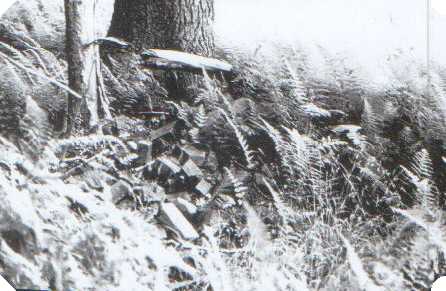
A portion of the area scattered with the crude,
homemade bricks found at Celestia.
1979---
Lynne Miller.

The location of the bricks in relation to the nearby lake.
1979---Lynne Miller.
However, there is one man who knows the Celestia site extremely well, and he is responsible for a most interesting discovery about Celestia and Armstrong. Mr. Willis Stepp, a surveyor from Laporte and grandson of Mr. William Mason,
(see footnote 86) surveyed the property of Celestia for the present owners. While he was doing his work he discovered that although Armstrong legally deeded four square miles of land to Almighty God (2560 acres), Armstrong owned only approximately 600 acres. How was it possible to deed more land than one actually owned to another party?(218)With this question in mind one must reread the deed. After describing the land's boundaries, the deed states: "Containing four square miles of land, of which we have redeemed about six hundred acres and we do hereby set apart by boundary with the intent to redeem the balance of said tract at or before the redemption of the world, as the purchased possession of Jesus Messiah."
(219) Prior to this discovery most readers interpreted this sentence to mean that Armstrong deeded four square miles to God of which he had cleared and made ready for use 600 acres with the intent to clear the remaining acreage of the property. However, the wit and education of Armstrong is plainly visible in this example of his literary and legal ability. Armstrong used the word "redeem" to mean that he presently owned only 600 acres of the four square miles and that he intended to purchase in the future the remaining acres. Thus he shrewdly included unowned land in the deed to God. Mr. Stepp is also responsible for finding the actual location of the city plan in relation to the village that had been built at Celestia.(220) (See map of Celestia.)Over the years the history of Celestia has been lost within the records of state history. The Commonwealth of Pennsylvania did erect a historical marker concerning Celestia along Route 220 near Laporte. Although the year of Armstrong's death should read "1887" the other information is consistent with Celestia's history:
"Celesta" Name of religious community founded by Peter E. Armstrong. Site is two miles west. In 1864, he and his wife deeded about 600 acres to "Almighty God and His heirs in Jesus Messiah, for their proper use and behoof forever." Armstrong died in 1884.(221)
The story of Celestia not only illuminates the life of a unique individual, but it also sheds light on the religious milieu of the nineteenth centruy. Armstrong's vision, which was born in times of great expectation and of great struggle for Millerite adventists, provided one of several reinterpretations after the Great Disappointment. Within the larger context of the forming Seventh-Day Adventist Church, the religious turmoil of the nation, and Armstrong's limited resources, Celestia had little hope for survival. The straightforwardness of Armstrong's faith and teachings clearly put to the test America's freedom of religion. However, freedom to form was no guarantee for growth and survival. As with many other religious and social utopias, Celestia died and the wilderness remains.
Although Celestia is now only wilderness, the vision is "a memorial to a man who was strong enough to carry out his own convictions."
(222) Peter E. Armstrong had a great faith, and a great plan, and he was willing to go to all costs to see the fulfillment of his vision take place. Even in his failure he demonstrated his unfaltering faith and his love for God as few men are willing to do. He believed he was that "mighty man of valor," and he dedicated his whole life to his divine mission. In the words of his granddaughter, Rita A. Wharton, "He really did believe what he was saying."(223)
FOOTNOTES
1. Hudson, Religion, pp. 181-182. See also: Ahlstrom, History, pp. 472-482.
2. Mitchell, Seventh-Day, p. 269.
3. Olsen, History, p. 142.
4. Mitchell, Seventh-Day, p. 287.
5. Littell, Living Age, p. 138.
6. Arthur, "Millerism", Rise, pp. 155-156.
7. Mitchell, Seventh-Day, pp. 278 and 289.
8. Harkness, Social, p. 23.
9. Harkness, Social, p. 24.
10. Harkness, Social, pp. 22-25.
11. Mitchell, Seventh-Day, p. 291.
12. Clark, Small Sects, p. 37.
13. Arthur, "Millerism", Rise, p. 200. In this reference, "between the times" refers to the period of time between Christ's cleansing of the heavenly sanctuary and Christ's return to earth prior to the final days.
14. Olsen, History, p. 251.
15. Magargle, "God's Country", Hodge-Podge, p. 32. Myrtle Magargle was a local historian who lived near Sonestown during the early 1900's.
16. Armstrong, "Elijah", Day Star, No. 5, pp. 6-7.
17. Armstrong, "Stone", Day Star, No. 5, pp. 1-2.
18. Armstrong, "Elijah", Day Star, No. 5, pp. 6-7.
19. This scriptural mandate to prepare seems to have been taken personally by Armstrong. Therefore, in a sense, Armstrong identifies himself as Elijah, who would usher in the Millennial Age.
20. Armstrong, "Stone", Day Star, No. 5, pp. 1-2.
21. Armstrong, "Elijah", Day Star, No. 5, pp. 6-7.
22. Armstrong, "Stone", Day Star, No. 5, pp. 1-2.
23. Armstrong, "Elijah", Day Star, No. 5, pp. 6-7.
24. Armstrong, "Least", Day Star, No. 10, pp. 1-3.
25. Armstrong, "Least", Day Star, No. 10, pp. 1-3.
26. Magargle, "God's Country", Hodge-Podge, p. 32.
27. Sources do not clearly indicate whether Armstrong saw his Celestia as the New Jerusalem or as the new birth place of Christ --- the new Bethlehem. Perhaps Armstrong conceived Celestia primarily in terms of the New Jerusalem; however, since Celestia would also be the place at which Christ would appear during the second advent, Armstrong sometimes referred to Celestia as Bethlehem.
28. Holcombe, "Celestia", p. 1. This play, written by Pauline Holcombe, a Sullivan County historian, was written for and performed at the Sullivan County Fair and at Valley Forge, Pennsylvania, as part of the American Bicentennial Celebration. The play is based on secondary sources and focuses on isolated events in the history of Celestia.
29. McFarland, Eagles Mere, pp. 16 and 79.
30. These letters were discovered by this author while interviewing Rita A. Wharton, oldest granddaughter of Armstrong, in April of 1979. There are twenty-two letters dating from May 10, 1884 to July 18, 1884. All but one was written by "P.E. Armstrong". The letters, which have been donated to the Sullivan County Museum, are most valuable to Celestia's history because they provide the only available information for the period after 1880. The letters have been numbered chronologically, and hereafter will be referred to as: "Letter #___________of 1884".
31. The objectives of Celestia (which will follow in the text) correspond to those listed in the Day Star of1880. The January edition (#5) only provided the first three objectives, but the fourth objective was included in both the April (#8) and the June (#10) editions.
32. See footnote #31.
33. Hayes, Introduction, p. 131.
34. Armstrong, "Stone", Day Star, No. 5, pp. 1-2.
35. Hayes, Introduction, p. 131.
36. Armstrong, "Stone", Day Star, No. 5, pp. 1-2.
37. Letter #3 of 1884. Although Armstrong was not willing to equate Celestia to the New Jerusalem, Letter #10 of 1884, written by Maria B. Curry, a resident of Celestia, did make the equation of Celestia with Mount Zion. She provided this understanding when she wrote the letter from "Celestia, Mt. Zion", and further addressed the topic in the letter.
38. Letter #3 of 1884.
39. Letter #4 of 1884.
40. Letter #4 of 1884.
41. Heading, Day Star, No. 5.
42. Heading, Day Star, No. 8 and No. 10.
43. Armstrong, "Brevity", Day Star, No. 5, p. 4.
44. Letter #4 of 1884. See also: Letter #22 of 1884.
45. Armstrong, "Stone", Day Star, No. 5, pp. 1-2.
46. Letter #3 of 1884.
47. Armstrong, "Stone", Day Star, No. 5, pp. 1-2.
48. See footnote #31.
49. Armstrong, "Elijah", Day Star, No. 5, pp. 6-7.
50. Armstrong, "Armageddon", Day Star, No. 8, p. 2. It should be noted that Armstrong did not denounce human law because he believed it was "Necessary for those who have not faith enough in God to live without it." ("Editor's Note: Day Star, No. 5, p. 6.).
51. Armstrong, "Elijah", Day Star, No. 5, pp. 6-7.
52. Armstrong, "Elijah", Day Star, No. 5, pp. 6-7.
53. Armstrong, "Armageddon", Day Star, No. 8, p. 2.
54. Armstrong, "Stone", Day Star, No. 5, pp. 1-2.
55. Smith, "Dictionary", p. 54.
56. Armstrong, "Stone", Day Star, No. 5, pp. 1-2.
57. See footnote #31.
58. Armstrong, "Life", Day Star, No. 5, p. 3. The scripture (John 8:51) was used by Armstrong as the text for the above article.
59. Armstrong, "Life", Day Star, No. 5, p. 3.
60. Armstrong, "Life", Day Star, No. 5, p. 3.
61. Armstrong, "Kingdom", Day Star, No. 8, pp. 1-2.
62. See footnote #31.
63. Armstrong, "Day Star", Day Star, No. 5, p. 4.
64. Armstrong, "Day Star", Day Star, No. 5, p. 4.
65. Ahlstrom, Religious, pp. 472-483.
66. Olsen, History, p. 137. William Miller spoke about the date of the second advent of Christ in Philadelphia on March 10, 1844. It is possible that Armstrong attended that lecture and may have been converted to the Millerites at that time. According to Olsen, Philadelphia was firm in adventist faith: "Something like a thousand persons testified to their faith in the doctrine taught" by Miller in Philadelphia in 1844. (Olsen, History, p. 141).
67. Information provided by Rita A. Wharton, Armstrong's granddaughter, during a taped interview on April 16, 1979.
68. Wood, Now and Then, Vol. 4, p. 19. According to Rita A. Wharton, Armstrong and his wife, Hannah, operated a paper or stationery store in Philadelphia; however, local historians, such as Wood, claim Armstrong's occupation was that of a rag collector and vendor of tinware which he peddled throughout the state.
69. Magargle, "God's Country", Hodge-Podge, pp. 32-33.
70. Deed Book, Vol. 2., p. 267.
71. Deed Book, Vol. 2., pp. 264-267.
72. Magargle, "God's Country", Hodge-Podge, p. 33.
73. Gwinett, "Coelesta". This is the only source where this spelling was used.
74. Magargle, "God's Country", Hodge-Podge, p. 33.
75. Wood, Now and Then, Vol. 4, p. 21. Wood had access to the Day Star (#9) from May of 1880. His thorough use of this primary source, which has since been lost, has been very helpful to subsequent researchers.
76. Magargle, "God's Country", Hodge-Podge, p. 33.
77. Wood, Now and Then, Vol. 4, p. 18.
78. Holcombe, "Celestia", p. 3.
79. This painting had been owned by Mary Montague of Hughesville, a granddaughter of Armstrong. After her death in 1974, the painting was given to her brother, Robert Armstrong of Hughesville. A copy of the painting was painted in 1979, and is now owned by D. Wayne Bender of Sonestown.
80. The spelling of the title was later corrected by scratching in the "ia" of Celestia over "Celesta".
81. Wood, Now and Then, Vol. 4, p. 22. While searching the Celestia area for foundations, a large pile of crude homemade bricks was found near the lake. The bricks, mostly broken, were never used in construction but may have been intended for use in building the Temple.
82. G.F. Armstrong was probably the son of George F. Armstrong, Armstrong's second son. The artist was known as G. Franklin Armstrong. (Rita A. Wharton).
83. "Oil Painting", The Sullivan Review, p. 1.
84. Wood, Now and Then, Vol. 10, p. 261.
85. Wood, Now and Then, Vol. 4, p. 18.
86. Wood, Now and Then, Vol. 4, p. 17. Much of the information that Wood used in his early writing was from an interview with Mr. William C. Mason. Mr. Mason, who was 82 at the time of the interview, had been the Sullivan County Supervisor for many years, and he remembered several humorous stories and anecdotes about Celestia.
87. Wood, Now and Then, Vol. 4, p. 19.
88. The letters, "Y-A-V-A-H", if Mason's memory was accurate would be an error in the English transliteration of "Yahweb". The correct spelling would be "Y-H-W-H" since the Hebrew language has no vowels.
89. Magargle, "God's Country", Hodge-Podge, p. 33.
90. Holcombe, "Celestia", p. 3.
91. Wood, Now and Then, Vol. 4, p. 18.
92. The origin of this folk story is unknown. It was provided by Freda and Alma Golder of Muncy Valley, who claim the story has passed down through their family for years. However, it should be noted that Armstrong never had a son named Peter, Jr. (see footnote 95). Also of interest is the fact Armstrong celebrated the Sabbath on Saturday, rather than Sunday (Letter #5 of 1884).
93. Holcombe, "Celestia", p. 3.
94. Magargle, "God's Country", Hodge-Podge, p. 35.
95. Rita A. Wharton. As a young girl, Mrs. Wharton kept a record of her family history in the cover oa a children's book that was given to her for a birthday. Following
is that information:
Peter Edward Armstrong May 18, 1818 --- June 20, 1887
Hannah Taylor Armstrong May 24, 1818 --- April 23, 1893
Children:
William B. July 28, 1841 --- July 23, 1913
George Frank October 4, 1843 --- July 8, 1912
John 1845 --- 1877
Alvah Taylor November 11, 1848 --- October 10, 1924
Michael Mylert August 31, 1851 --- October 13, 1910
Mary Ida (Craig) 1856 --- 1924
Lewis D. June 5, 1859 --- August 3, 1891
96. Wood, Now and Then, Vol. 4, p. 18. Both Rita A. Wharton and Edna Hill, granddaughters of Armstrong, do not recall that Eva Kamm ever lived with Peter and
Hannah Armstrong.
97. Armstrong, "Notice", Day Star, No. 5, p. 1.
98. The distribution of the first Day Star in January of 1880, was done by mailing 100,000 copies, one to every Post Office in the United States. Each reader was asked
to make a donation to Celestia, to subscribe to the newspaper, and to pass his copy of the paper on to a neighbor. A subscription to the paper was $.50 for a year,
or $.05 for one copy. (Armstrong, "Terms of the Paper", Day Star, No. 5, p. 1.).
99. Armstrong, Letter to George Jackson.
100. Armstrong, "Correspondence", Day Star, No. 5, p. 8.
101. Armstrong, Letter to George Jackson.
102. Deegan, et al., Letter to "All Whom It May Concern".
103. Armstrong, Letter to George Jackson.
104. Ingham, History, p. 49.
105. Journal of the House of Representatives, 1864, p. 267.
106. Armstrong, Letter to George Jackson.
107. Armstrong, Letter to George Jackson.
108. This conclusion is made after detailed and comprehensive search of records at the State Library and the Archives Room of the William Penn Museum. State officials
are doubtful the petition was ever acted on in committee, and are certain the petition is not among State records.
109. Ingham, History, pp. 49-50.
110. Journal of the House of Representatives, 1864, pp. 266-267.
111. Armstrong, "Correspondence", Day Star, No. 5, pp. 7-8.
112. Armstrong, "Correspondence", Day Star, No. 5, p. 8.
113. Armstrong, "Correspondence", Day Star, No. 5, p. 8.
114. Deed Book, Vol. 7., pp. 25-26. The deed was sealed on June 14, 1864, and was recorded on August 4, 1864, by John S. Greene, a recorder for Sullivan County. The original deed is now in the possession of Robert Armstrong of Hughesville.
115. Armstrong, "Correspondence", Day Star, No. 5, p. 8.
116. Magargle, "God's Country", Hodge-Podge, p. 34.
117. "Why Celestia", New York American.
118. Deed Book, Vol. 7., p. 26.
119. Deed Book, Vol. 7., pp. 25-26.
120. Deed Book, Vol. 7., pp. 25-26.
121. Magargle, "God's Country", Hodge-Podge, p. 35.
122. Armstrong, "Correspondence", Day Star, No. 5, pp. 7-8. A letter from E. Rowley of Leichester, Wisconsin, to Armstrong evidenced concern about the deed in a unique way:
In other words, Rowley did not give much credit to the deeding of the land to God, because it was, at most, only a symbolic action. However, not wanting to outrightly condemn Armstrong's action, he closed his letter asking the Lord to increase both their faiths. (Armstrong, "Correspondence", Day Star, No. 5, p. 7).
123. Armstrong, "Correspondence", Day Star, No. 5, p. 8.
124. Armstrong did not always sign his articles which appeared in the Day Star; however, he did include the notice that all the articles which did not bear a name could be assumed to be the work of the editor, Peter E. Armstrong.
125. Armstrong, "Editor's Note", Day Star, No. 5, p. 7.
126. Magargle, "God's Country", Hodge-Podge, p. 34.
127. Armstrong, "Correspondence", Day Star, No. 5, p. 8.
128. Wood, Now and Then, Vol. 4, p. 18.
129. The actual spelling of Glen Sharon has also been disputed. Spellings that have been used by sources include: Glensharon, Glenn Sharon, Glen Sharron, and Glen Sharon. For reason of consistency, the spelling "Glen Sharon" will be used.
130. Deed Book, Vol. 10., p. 673. (A perch = 30 1/4 square yards).
131. Deed Book, Vol. 10., pp. 671-672.
132. This fact is known because several letters which appeared in the Day Star were dated from Philadelphia, and there are also some references to Philadelphia in the January edition of the Day Star. (Day Star, No. 5.).
133. Letter #17 of 1884.
134. Magargle, "God's Country", Hodge-Podge, p. 36.
135. The layout of Glen Sharon is possible because of interviews with Rita A. Wharton and Edna Hill who recall the village setting, and also through the use of lot descriptions recorded within the deeds at the Sullivan County Court House. (These sources are in partial contradiction to the description of Glen Sharon provided by Magargle, "God's Country", Hodge-Podge, p. 36.).
136. References to First Street are only mentioned in the writing of Myrtle Magargle. However, it would seem logical that First Street would be the main Highway passing through Glen Sharon.
137. Deed Book, Vol. 11., pp. 194-195. "Sharon Street" as it is called in the deed of Mary McClain's property seems to have been confused by Magargle to have been "Second Street".
138. Rita A. Wharton.
139. Edna Hill and Rita A. Wharton.
140. Magargle, "God's Country", Hodge-Podge, p. 36.
141. Edna Hill and Rita A. Wharton.
142. Edna Hill and Rita A. Wharton.
143. Story as remembered by James St. Clair of Sonestown.
144. Armstrong, "Correspondence", Day Star, No. 5, p. 8.
145. Magargle, "God's Country", Hodge-Podge, p. 37.
146. Deed Book, Vol. 11., pp. 425-426.
147. Magargle, "God's Country", Hodge-Podge, p. 37.
148. Deed Book, Vol. 11., pp. 194-195.
149. Magargle, "God's Country", Hodge-Podge, p. 37.
150. Mary McClain's Scrapbook. It contains newspaper articles and newsprint poetry which Miss McClain found interesting. Much of the information focuses on the temperance movement. On the last few pages of the book are several letters written by Miss McClain stating her disapproval of alcohol and describing her work as a prohibitionist. It is also here that two important letters are found about Celestia and Glen Sharon.
151. Mary McClain Scrapbook, "Glensharon". Although the letter is not signed, it can be deduced that Miss McClain was the author. The date of the letter is unknown; however, it was probably written in 1876. The newspaper in which the letter appeared is also unknown.
152. Mary McClain Scrapbook, "Glensharon".
153. Magargle, "God's Country", Hodge-Podge, pp. 37-38.
154. Magargle, "God's Country", Hodge-Podge, p. 38.
155. Mary McClain Scrapbook. Although the previously described letter was not found, a similar letter written by Miss McClain was found in her scrapbook and dated April 20, 1878. The letter was warning others about the growing immorality of Glen Sharon. This letter, entitled "A Voice From the Vale of Glensharon", seems to have been a response to the letter written two years before (see above). In this second letter, Miss McClain withdraws her positive descriptive statements concerning the beauty of Glen Sharon and the work of Armstrong.
156. Mary McClain Scrapbook, "A Voice From the Vale of Glensharon".
157. The only information regarding the tax sale of the Lord's property is provided by two similar newspaper articles which have beensaved by Rita A. Wharton. The articles are: "Ruins Mark Land Deeded In 1864 for Use of Deity" and "Strange Deed Willed Property to God".
158. Magargle, "God's Country", Hodge-Podge, p. 35.
159. "Why Celestia", New York American.
160. "Strange Deed", The Grit, p. 8.
161. "Ruins Mark Land", Public Ledger, p. 2.
162. Rita A. Wharton.
163. "Ruins Mark Land", Public Ledger, p. 2.
164. Letter #4 and #13 of 1884.
165. Letter #1 of 1884.
166. Letter #21 of 1884.
167. Rita W. Wharton. John Armstrong's children were Laura, Sam, Perce, and Minnie. Nothing is known about his wife.
168. Armstrong, "Notice", Day Star, No. 5, p. 1.
169. Letter #20 of 1884.
170. "Why Celestia", New York American.
171. Letter #3 of 1884.
172. Letter #3 of 1884.
173. Letter #7 of 1884.
174. The year of 1884 is very symbolically significant. First, it would have been 40 years since the "Tenth day of the seventh month" in 1844, the date of the Great Disappointment. It is also seven years since the vision of the tabernacle was first realized. Armstrong provided the justification for the date in Letter #1 of 1884:
175. Letter #11 of 1884.
176. The scripture for this prophecy may have been Daniel 2:31-35.
177. Letter # 9 of 1884.
178. Letter #11 of 1884.
179. Letter #18 of 1884.
180. Letter #9 of 1884.
181. Letter #9 of 1884. The scripture given refers to Isaiah 60:13.
182. Letter #12 of 1884. This letter suggested that the first number of the Day Star to be published in 1884 would be #12. Therefore, previous editions of the Day Star would have been eleven even though only three editions were available to this author.
183. Letters #12, #15, #19 of 1884.
184. Letter #13 if 1884.
185. Letter #15 of 1884. The term "visionary" can be understood as one who sees visions of the future; however, Armstrong uses the term as a derogatory comment for those whose visions were inconsistent with his own. One of the other visionaries mentioned in the Letters of 1884 was Mr. Trowbridge, who never was permitted to live at Celestia, but caused trouble for Armstrong while he lived at Glen Sharon. (Letters #3 and #15 of 1884).
186. Letter #15 of 1884.
187. Letter # 21 of 1884.
188. Letters #1 and #14 of 1884.
189. Letter #19 of 1884.
190. The Day Star (#9) provided the most up to date report regarding the funds received for the building of the Temple. There had been $1,061.73 received, with $2,500.00 pledged, and there were as yet no expenditures in May, 1880. (Wood, Now and Then, Vol. 4, p. 22).
191. Letter #12 of 1884.
192. Letter #6 of 1884.
193. Magargle, "God's Country", Hodge-Podge, p. 35.
194. Letter #21 of 1884.
195. Letter #13 of 1884.
196. Letter #20 of 1884.
197. Letter #6 of 1884.
198. Armstrong, "Celestia", Day Star, No. 5, p. 1.
199. Register of Wills: Peter E. Armstrong.
200. Magargle, "God's Country", Hodge-Podge, p. 39.
201. Rita A. Wharton. (See footnote #95).
202. Magargle, "God's Country", Hodge-Podge, p. 40.
203. "Strange Deed", The Grit, p. 8.
204. Magargle, "God's Country", Hodge-Podge, p. 40.
205. Magargle, "God's Country", Hodge-Podge, p. 39.
206. Deed Book, Vol. 34., pp. 371-373.
207. Clyde E. Sheets.
208. Clyde E. Sheets.
209. Russell Quava.
210. Register of Wills: Mary McClain.
211. Rita A. Wharton.
212. Magargle, "God's Country", Hodge-Podge, p. 38.
213. Inventory and Appraisement List of Decedents Estate: Mary McClain. These records also show that Miss McClain had only one relative living, a nephew, in Iowa.
214. Register of Wills: Peter E. Armstrong.
215. "Ruins Mark Land", Public Ledger, p. 2.
216. Deed Book, Vol. 7., pp. 25-26.
217. Edna Hill.
218. W. R. Stepp.
219. Deed Book, Vol. 7., pp. 25-26.
220. W. R. Stepp.
221. This sign is located on Route 220, near the Laporte intersection of Route 42.
222. "Little Remains", The Grit, pp. 35 and 38.
223. Rita A. Wharton.
BIBLIOGRAPHY
Ahlstrom, Sydney E. A Religious History of American People.
New Haven: Yale University Press, 1972.
Armstrong, Peter E. "Notice" (p. 1), "The Stone Kingdom" (pp. 1-2), "Life Without Death" (p. 3.), "Items of Brevity" (p. 4.), "The Day Star" (p. 4.), "The Work of Elijah"
(pp. 6-7), "Correspondence" (pp. 7-8). in The Day Star ofZion and Banner of Life. No. 5. Philadelphia and Celestia: Charles T. Baker, 1880.
Armstrong, Peter E. "The Kingdom of Heaven" (pp. 1-2), "Armageddon" (p. 2). in The Day Star ofZion and Banner of Life. No. 8. Philadelphia and Celestia: Charles
T. Baker, 1880.
Armstrong, Peter E. "The Least One in the Kingdom" (pp. 1-3). in The Day Star ofZion and Banner of Life. No. 10. Celestia: P.E. Armstrong, 1880.
Armstrong, Peter E. Letters of 1884. Letters #1-22. May 10, 1884 to July 18, 1884.
Armstrong, Peter E. Register of Wills, 1887. Sullivan County Court House.
Arthur, David T. "Millerism" in The Rise of Adventism edited by Edwin S. Gaustad. New York: Harper & Row, 1974.
The Bible: Revised Standard Version.
Clark, Elmer T. The Small Sects in America. New York: Abingdon --- Cokesbury Press, 1949.
Deed Book. Sullivan County: Commonwealth of Pennsylvania:
Vol. 2, p. 267, 1853.
Vol. 7, pp. 25-26, 1864.
Vol. 10, pp. 671-673, 1872.
Vol. 11, pp. 194-195, 1874 and pp. 425-426, 1873.
Vol. 34, pp. 371-373, 1915.
Deegan, James, (et al.). a letter "To all Whom it may Concern". from elected officials of Sullivan County, 1864. (available in Sullivan County Historical Museum, Laporte, PA).
Gwinett. (only name given) "Coelesta". Sullivan County Democrat, April 5, 1853 as reprinted in "1853 Sullivan County Democrat Article Describes Celestia". The Sullivan
Review. Vol. 102. No. 27. Dushore: The Sullivan Review, 1979.
Harkness, Ruben Elmore Ernest. Social Origins of the Millerite Movement. Chicago: University of Chicago, 1927.
Hayes, John. Introduction to the Bible. Philadelphia: Westminster Press, 1971.
Hill, Edna. Taped interview. Picture Rocks, PA. April 14, 1979. (Tape available at Sullivan County Historical Museum, Laporte, PA.).
Holcombe, Pauline. "Celestia", Unpublished play. (written for 1976 American Bicentennial).
Hudson, Winthrop S. Religion in America. New York: Charles Scribner's Sons, 1973.
Ingham, Thomas J. History of Sullivan County. Chicago: Lewis Publishing Company, 1899.
Journal of the House of Representatives of the Commonwealth of the Session begin at Harrisburg on January 5, 1864. Harrisburg: Singerly and Myers, 1864.
Littell, E. Living Age. Vol. 24. Boston: E. Littell and Company, 1850.
"Little Remains of Former Community". in The Grit. Williamsport: Grit, July 21, 1974.
Magargle, Myrtle. "God's Country --- Celestia". in Historic Hodge-Podge. edited by Harry H. Greene. New York: Tioga Publishing Company, 1955.
McClain, Mary. Scrapbook. Ca. 1860-1880. "Glensharon" and "A Voice From the Vale of Glensharon, Near Sonestown --- Growing Immorality of the Place".
McClain, Mary. Inventory and Appraisement List of Decedents Estate, 1899. (Sullivan County Court House).
McClain, Mary. Register of Wills, 1899. (Sullivan County Court House).
McFarland, J. Horace and Robert B. McFarland. Eagles Mere and The Sullivan Highlands: Origin and History of the Region. Harrisburg: J. Horace McFarland Company,
1944.
Mitchell, David. Seventh-Day Adventists --- Faith in Action. New York: Vantage Press Inc., 1958.
"Oil Painting in Home at Laporte, Accurate Picture of Famous Celestia". The Sullivan Review. Vol. 82. No. 34. Dushore: The Sullivan Review, 1959.
Olsen, M. Ellsworth. A History of the Origin and Progress of Seventh-Day Adventists. New York: Review and Herald Publishing Association, 1972.
Quava, Russell. Interview. Muncy Valley, PA. August 14, 1979.
"Ruins Mark Land Deeded in 1864 for use of Deity", Public Ledger, Philadelphia, August 2, 1931.
St. Clair, James. Interview. Sonestown, PA. July 14, 1979.
Sheets, Clyde E. Interview. Sonestown, PA. July 10, 1977.
Smith, William. A Dictionary of the Bible. Grand Rapids: Zondervan Publishing House, 1948.
Stepp, W.R. Interview. Laporte, PA. July 23, 1979.
"Strange Deed Willed Property to God" in The Grit. Williamsport: The Grit, March 5, 1933.
Wharton, Rita A. Taped Interview. South Williamsport, PA. April 16, 1979. (Tape available at Sullivan County Historical Museum, Laporte, PA).
"Why Celestia, City Deeded to God, Is Now Only a Ruin", New York American. New York: American Weekly, Inc. April 5, 1936.
Wood, T. Kenneth. "Celesta". Now and Then, Vol. 4. Williamsport: Williamsport Printing and Binding Company, 1936.
Wood, T. Kenneth. ed. Now and Then. Vol. 10, No. 9. Muncy Historical Society and Museum of History, 1953.
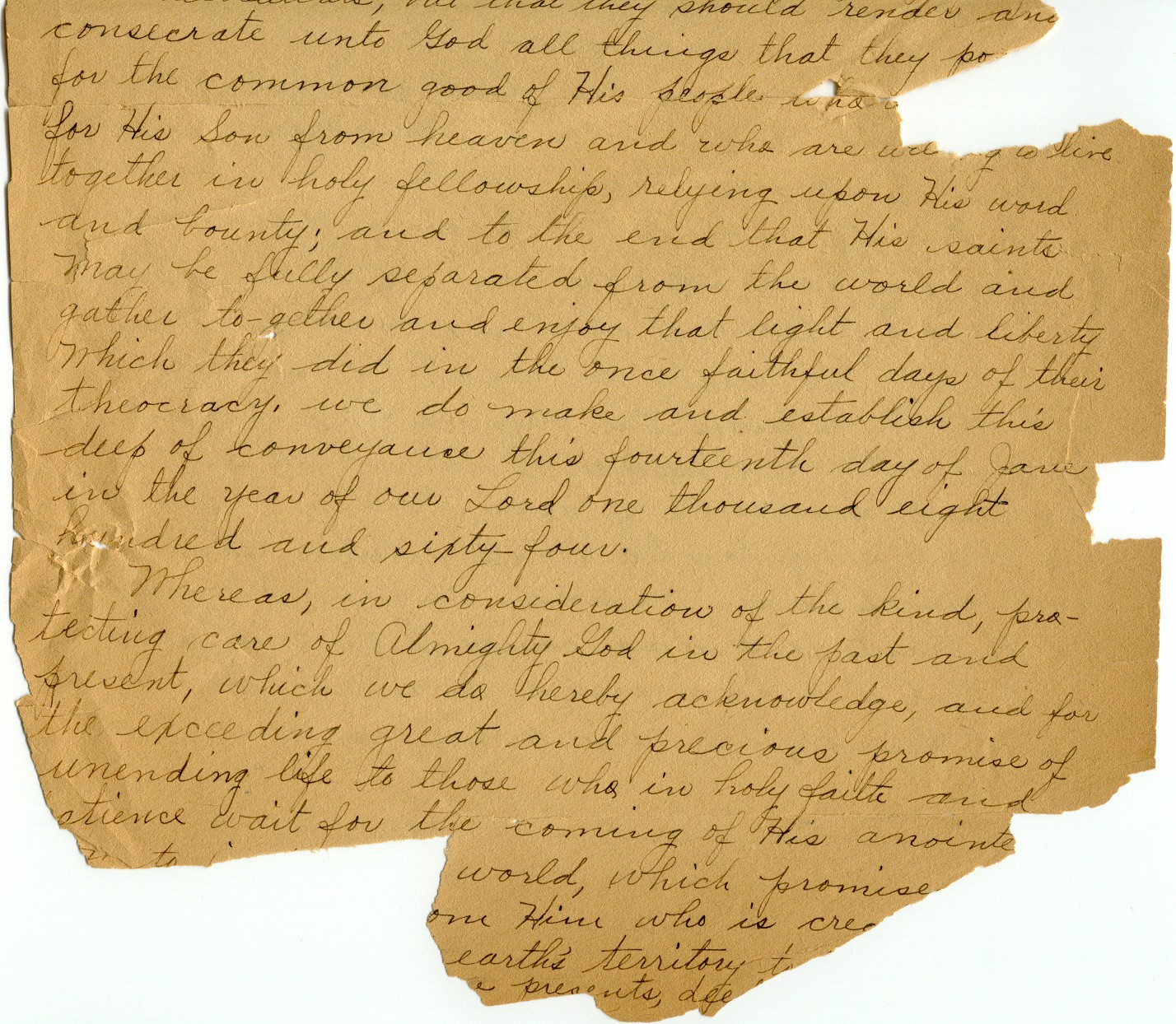
Indenture Willing the Land Under Celestia to God
Bottom half of first page
June 14, 1864
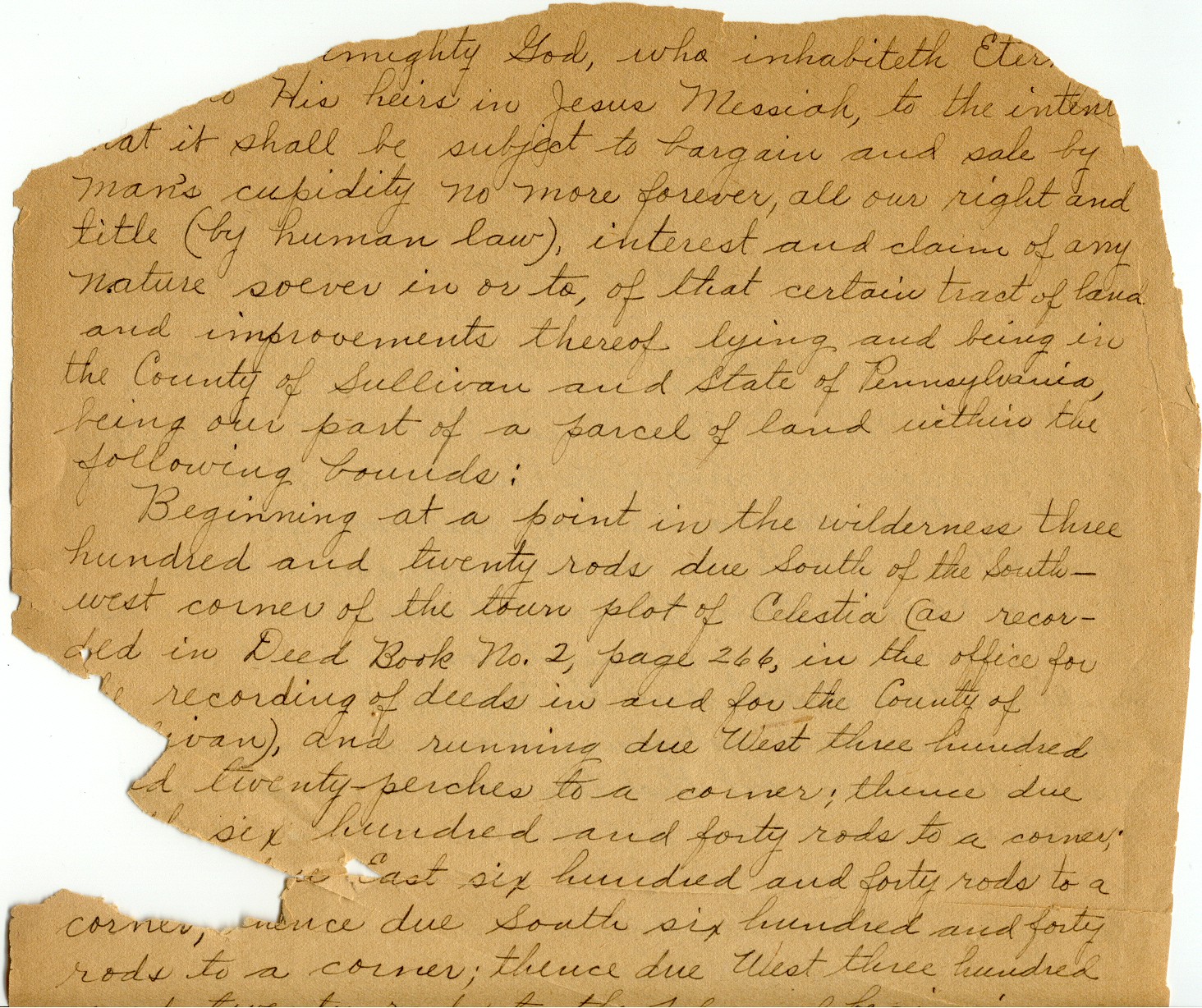
Indenture Willing the Land Under Celestia to God
Top half of second page
June 14, 1864
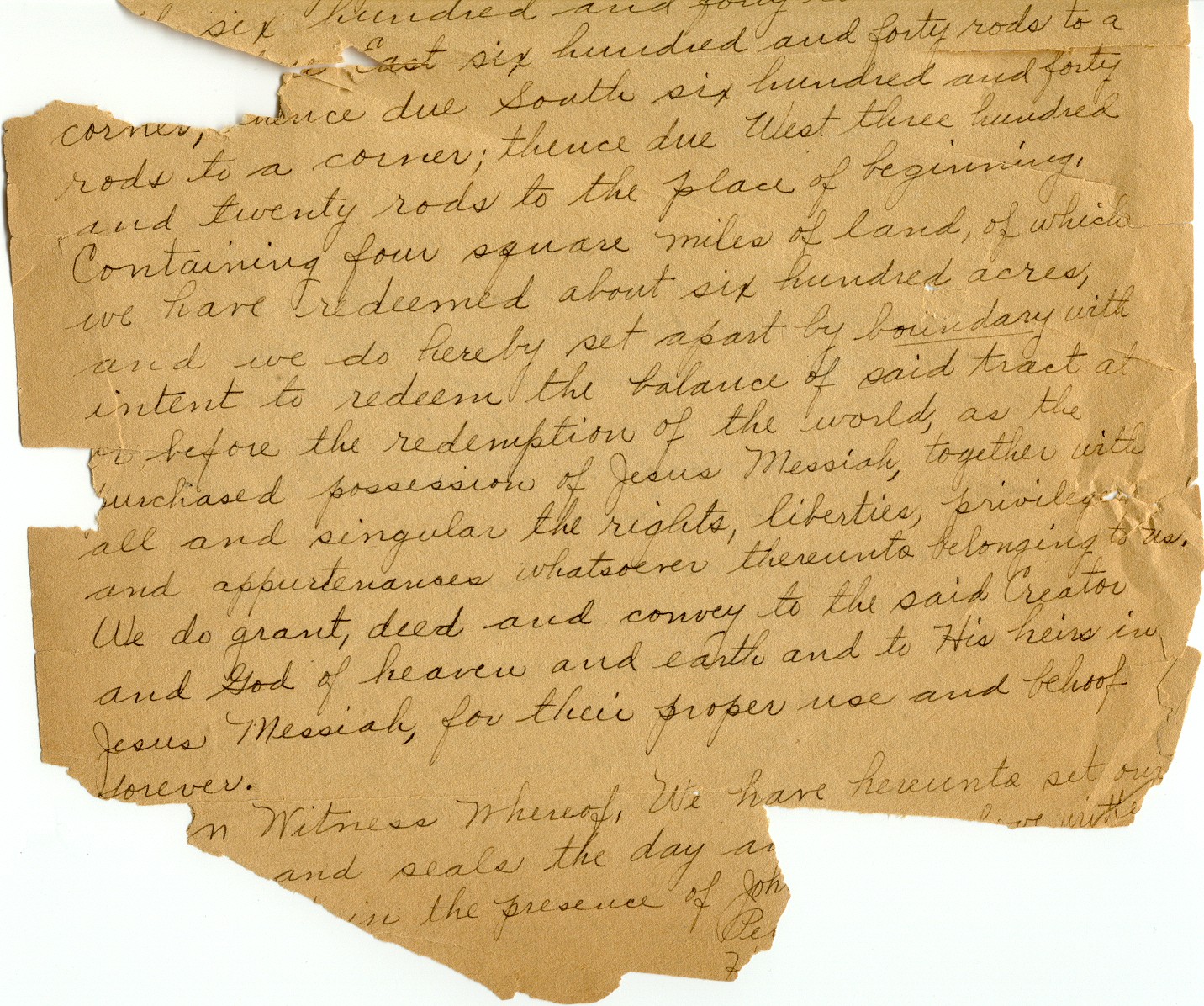
Indenture Willing the Land Under Celestia to God
Bottom half of second page
June 14, 1864
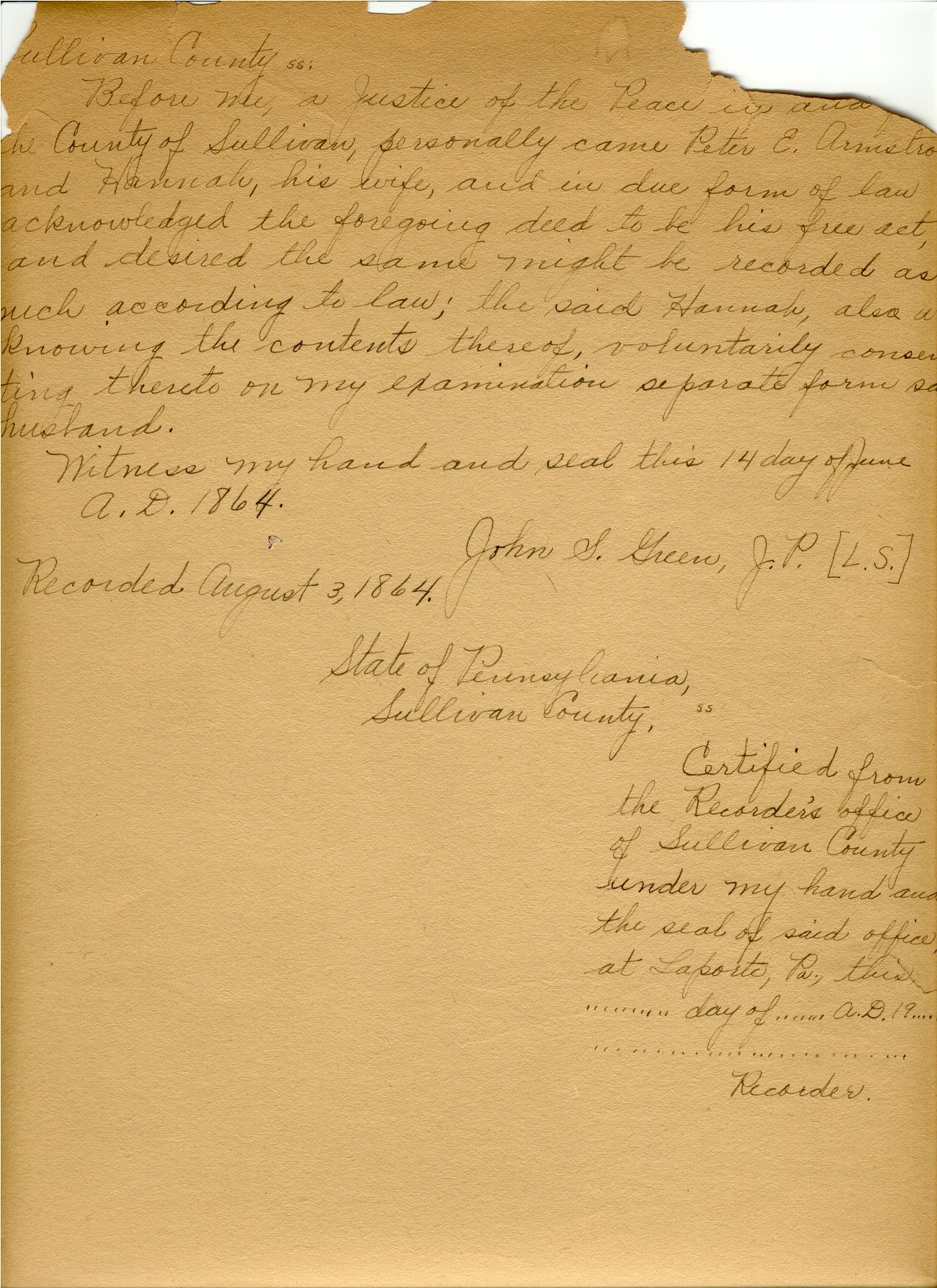
Indenture Willing the Land Under Celestia to God
Last or signature page
June 14, 1864
Copyright © 2002 Robert E. Sweeney and individual Contributors. All Rights Reserved. Prior written permission is required from Robert E. Sweeney and individual Contributors before this material can be printed or otherwise copied, displayed or distributed in any form. This is a FREE genealogy site sponsored through PAGenWeb and can be reached directly at ~Sullivan County Genealogy Project (http://www.rootsweb.com/~pasulliv)